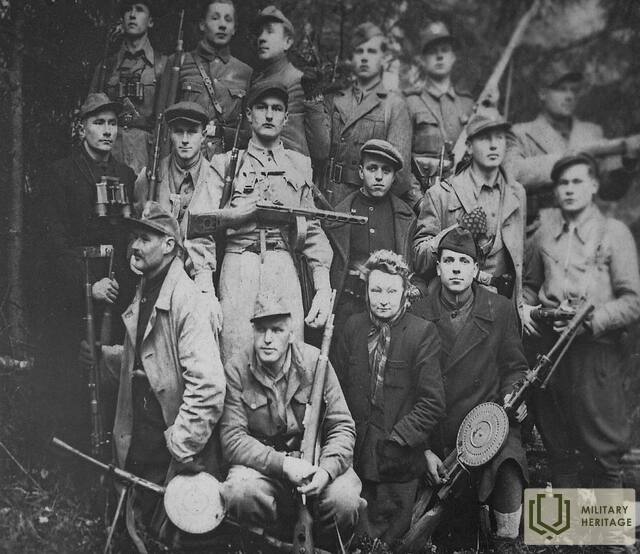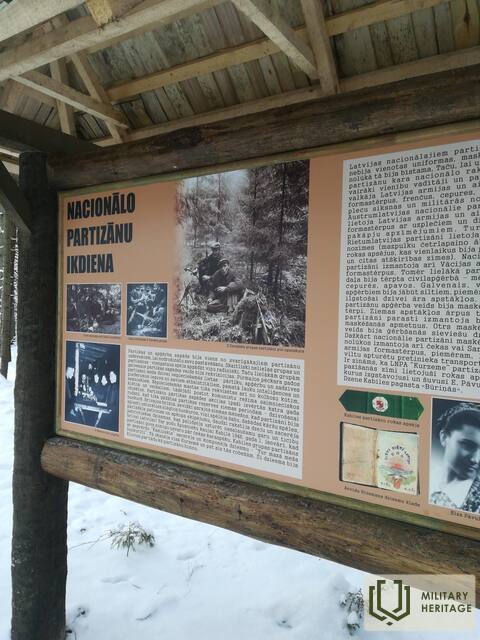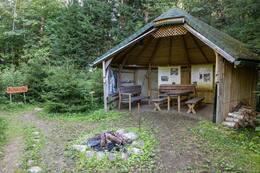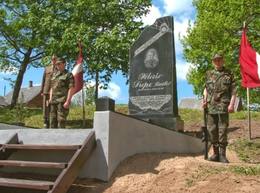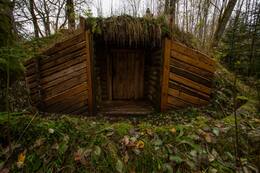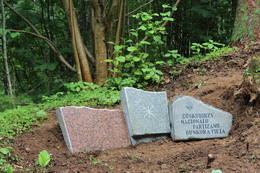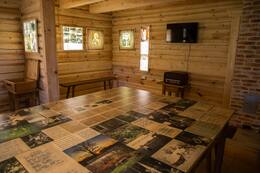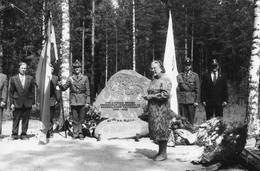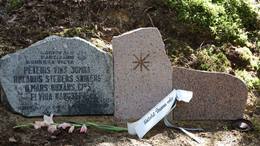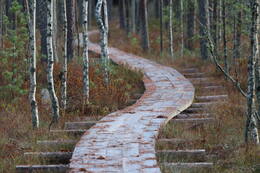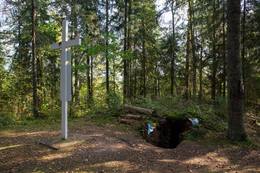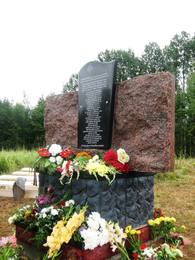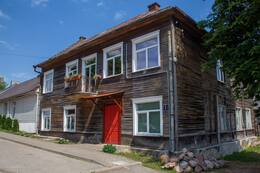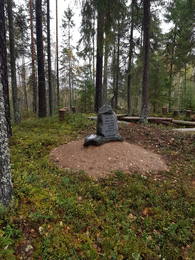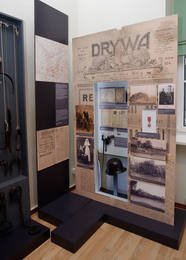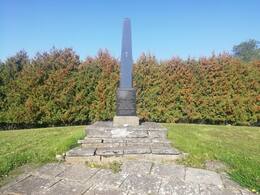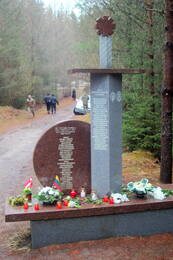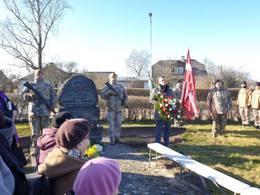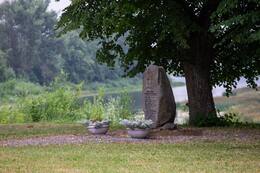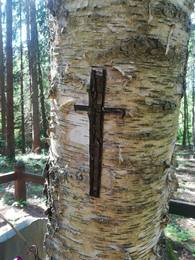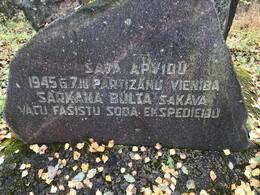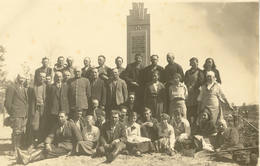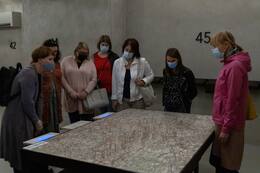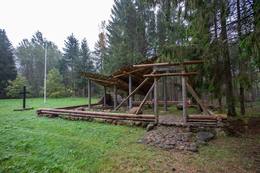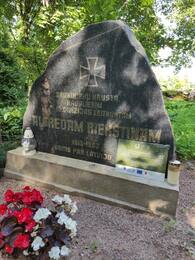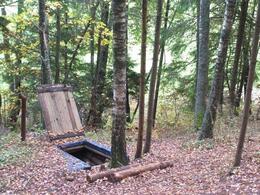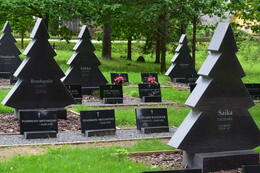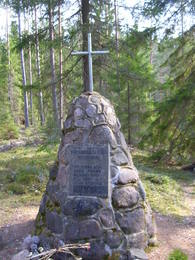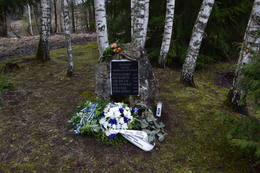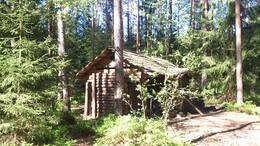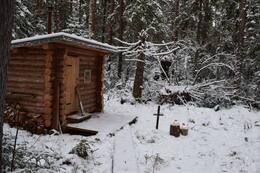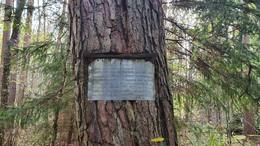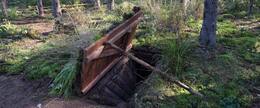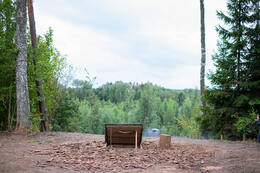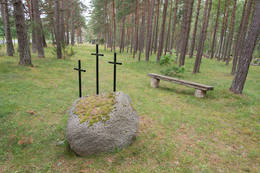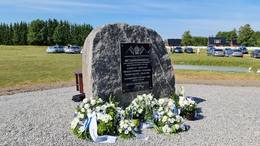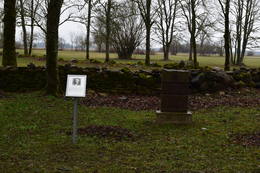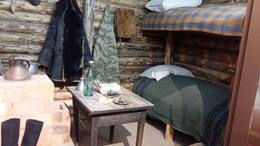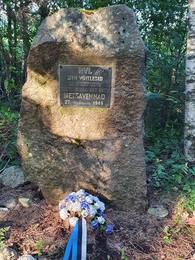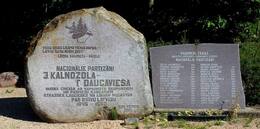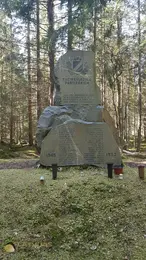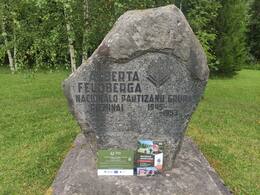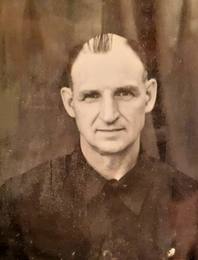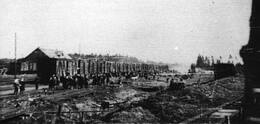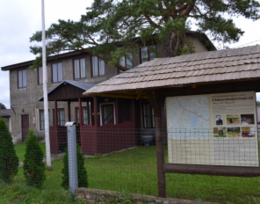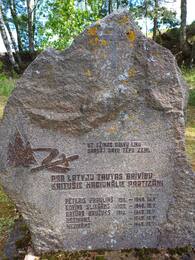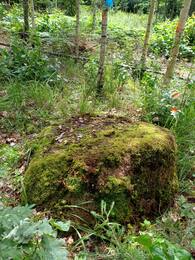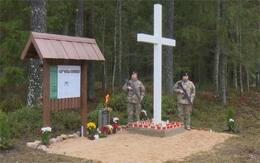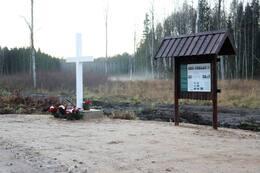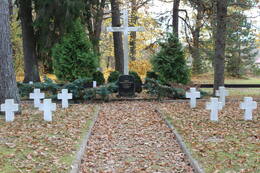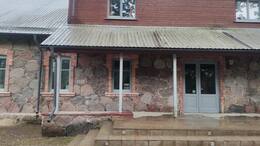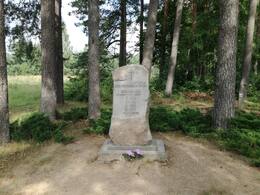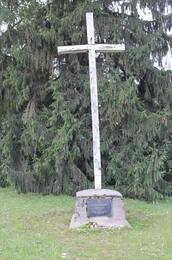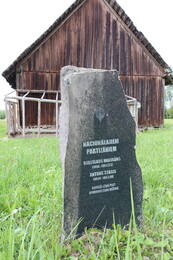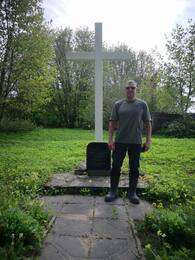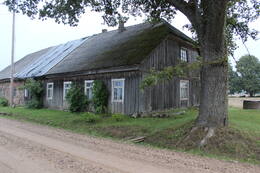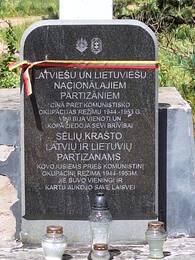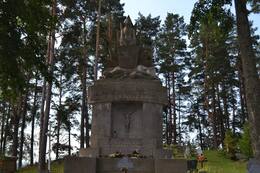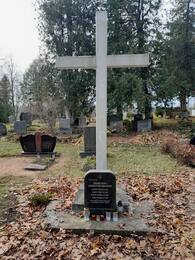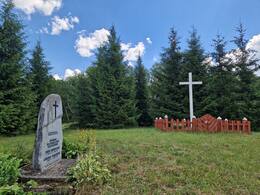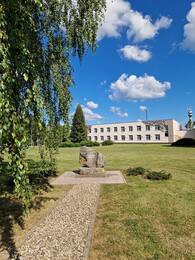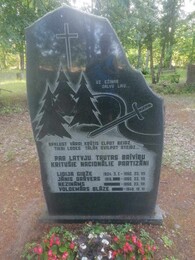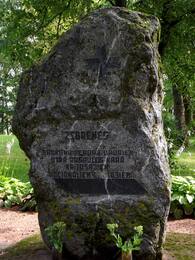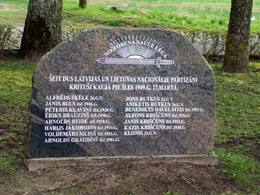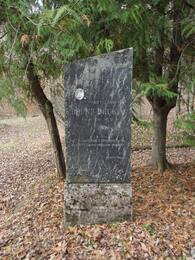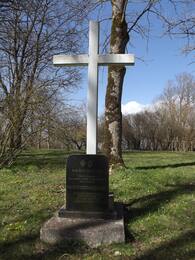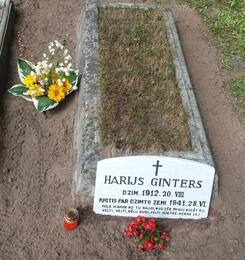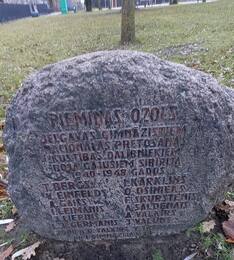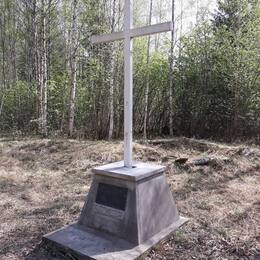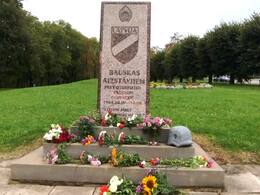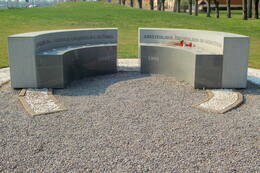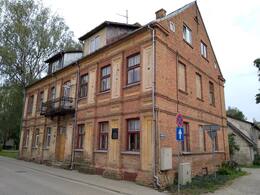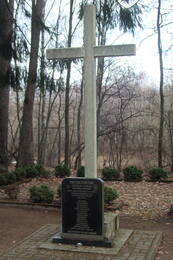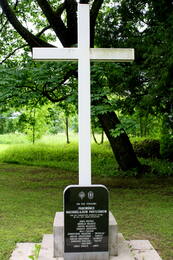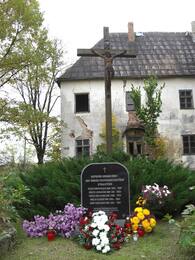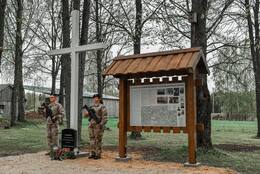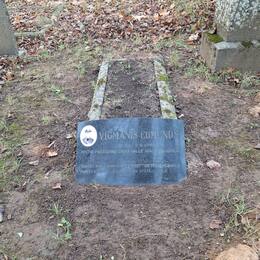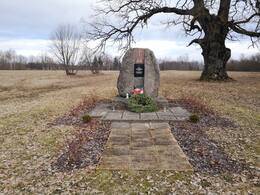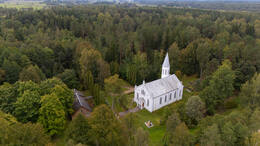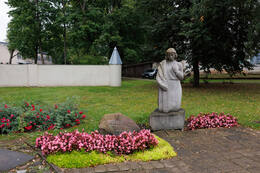Национальные партизаны/Лесные братья
II Вторая мировая война, III Национальное движение сопротивления, “лесные братья”
The national partisans or Forest Brothers were small, armed groups of local residents who fought their independent battles against the occupation regime of the USSR in the territory of Latvia from 1944 to 1956.
Forced to hide in the forests, these were people who could not or did not want to live in the Soviet Union. They were residents of Latvia who fought the occupation regime of the USSR from August 1944 to May 1957 through armed struggle and guerrilla warfare.
Partisan battles with the forces of the occupation regimes took place starting from the late summer of 1944.
In total, there were approximately 20193 forest brothers/ national partisans in Latvia
Дополнительные источники информации
Latvian National Partisan Battles - National Encyclopedia (enciklopedija.lv)
Связанная хронология
Связанные объекты
«Межа бральи» («Mežabrāļi») – бункер национальных партизан
Бункер «Межа бральи» («Mežabrāļi») расположен возле шоссе Рига - Псков (А2), в 76 км от Риги и в 11 км от Цесиса. Латвийские национальные партизаны или лесные братья были небольшими вооруженными группами местного населения, которые самостоятельно боролись против оккупационного режима СССР на территории Латвии с 1944 по 1956 год. Это были люди, которые не могли или не хотели жить в Советском Союзе и были вынуждены скрываться в лесах. Всего в Латвии насчитывалось около 20193 лесных братьев. Бункер был создан на основе рассказов и воспоминаний бывших лесных братьев о жизни в лесах, скрываясь и борясь за независимое Латвийское государство после 1945 года. В бункере размещена экспозиция вооружения и предметов быта. Здесь можно осмотреть личные вещи, оружие и фотографии партизан. Рассказ гида дополнен видеороликом с интервью лесных братьев. У бункера оборудована площадка для пикника с местом для костра. Можно заранее заказать суп, приготовленный на огне, или провести вечер у костра в открытом кинотеатре.
Battles and memorials of national and Soviet partisans in the Griva forest massif
It is located in the Griva forest massif.
Six objects related to the places of national and Soviet partisan battles are under consideration.
In the forest massif of Griva, there are not only the headquarters of the "Purvsaliņi" national partisans, the White Cross in the bunker of the national partisans and the cross to the commander of the resistance movement Andrejas Roskoš, but also the grave of the Soviet partisan brigade commander Artūrs Balož, a monument on the so-called Maiden Hill, where a Soviet partisan died in 1944 the group of young partisans of the brigade, as well as a monument to the Soviet partisans with a five-pointed star and the engraved words "Let's cover ourselves with needles".
It is also possible to view the objects by going for a ride with a two-wheeler on bicycle route no. 785 - "Rhymes of history in the forests of Griva" (route length 34 km, gravel and forest roads). Map for download.
Memorial place for the commander of the national partisan group Andrejas Roskoš (GPS 56.87399, 27.43524)
In the autumn of 1997, the White Cross was discovered in Lielgrivas forest for the commander of the national partisan group Andrejas Roskoš.
Monument to Artūrs Balodis (GPS 56.872926, 27.478121)
Artūrs Balodis was a Soviet partisan, the commander of special tasks of sub-unit A, which was stationed in the Griva forest massif. Fell in the extensive "combing" carried out by the occupiers of Nazi Germany. The comrades carved the letters AB in the birch tree at the place where he died, so that it would not be forgotten. After the war, local researchers found the marked birch and installed a commemorative plaque in its place.
For all those who fell in the forests of Griva (GPS 56.863280, 27.47975)
This commemorative stone in the Griva forest massif has been installed by VAS "Latvijas valsts meži" in honor of the partisans who fought for their homeland. Next to the memorial stone, there is a map-scheme with indications of the partisans' headquarters and places of interest. There is also a rest area. Nearby is the settlement of the national partisans, 1945-1947.
National partisans settlement (GPS 56.863456, 27.481148)
In this place there were settlements of national partisans who fought against the Soviet occupation. The places of individual bunkers have been preserved, by their visual appearance you can judge how big and what shape the dugouts were. National partisans, resisting the Soviet power, operated in the forests of Griva for several years after the end of the Second World War.
Griva forest memorial ensemble, dugout (GPS 56.860665, 27.490439)
It was built in memory of the Soviet partisans who lived in the forests of Griva. Guerrillas blew up the local railway network and trains to disrupt the supply of ammunition, food, etc. to the Nazi German army. Memorial stones have been placed in places where trenches were dug during the war. In the restored dugout you can feel the atmosphere of wartime.
Girls' hill (GPS 56.858187, 27.521526)
In June 1944, the occupiers of Nazi Germany carried out an extensive "combing" of the Griva forests with the intention of destroying the partisans. The soldiers on the hill of Numerne besieged the economic company, which consisted mostly of young girls, and all of them were shot. Since these tragic events, Numerne hill was renamed Meitenu hill by local residents. A memorial stone has been erected at this location.
Памятник командиру Северо-восточных национальных партизан Петерису Супу - «Чинитис»
В память о национальном командире партизан Петерасе Супесе 28 мая 2005 г. в Вилакасе был открыт памятник, посвященный ему. Он расположен возле Вилякской католической церкви, на краю вырытых во время войны траншей, где чекисты хоронили расстрелянных национальных партизан. Под памятником П. Супему помещена капсула с именами 386 павших национальных партизан, описаниями боев и материалами о партизанском командире. Слова, высеченные в камне: «Я оставался верным тебе, Латвия, до последнего вздоха».
Памятник создал Петерис Кравалис.
Рядом с ним мемориальное место в Стомпакском лесу и других местах боев борцов за свободу Латвии, павших и убитых чекистами в 1944-1956 годах.
20 июня 2008 г. на правой стене была обнаружена гранитная доска с именами 55 павших партизан, расположенными в три столбца.
Памятник установлен на том месте, где когда-то коммунистические оккупационные власти выставляли останки убитых партизан для устрашения остального населения.
На соседней табличке выгравированы слова благодарности Петерису Супе и стихотворение Брониславы Мартужевой:
«Вставай, Питер Супе,
Душа, в бой!
Сегодня Твоя кровавая жертва,
Восстал в нации.
Уходи, чтобы жить вечно
В силе и бодрости молодых,
Заворачивается, трепещет, складывается
В поднимающемся флаге!»
Erinnerungsstätte für die nationalen Partisanen von Sērmūkši mit Unterstand
In Sērmūkši befindet sich eine der mehr als einhundert Partisanen-Erinnerungsstätten in Lettland. Insgesamt fanden an mehr als sechshundert Orten in Lettland Partisanenkämpfe statt. Der nach historischen Vorbildern erbaute Unterstand lettischer nationaler Partisanen bietet nach vorheriger Anmeldung Übernachtungsmöglichkeiten - Holzpritschen, Petroleumlampen und Heizen wie zu Zeiten der Partisanen. Das Schicksal ereilte die Gruppe der nationalen Partisanen von Sērmūkši am 29. November 1946, als vier Kämpfer der Gruppe fielen - Jānis Zīrāks, Reinholds Pētersons, Jānis Pīlands, Anna Zariņa. Alfrēds Suipe entging diesem Schicksal. Er überlebte auch die Deportation, kehrte nach Lettland zurück und erlebte die Wiedergeburt des freien Lettland. Auf seine Initiative hin entstand diese Erinnerungsstätte für seine gefallenen Kameraden in Sērmūkši.
Gedenkstein für die nationalen Partisanen der Pfarrei Alsviķi „Schlangenplatz“
Befindet sich in "Čūskubirzs", Gemeinde Alsviķi, Bezirk Alūksne.
Der Gedenkstein wurde am 21. August 2018 enthüllt. Akmeņkalis Ainārs Zelčs.
Hier im Waldmassiv ist eine Bunkeranlage erhalten geblieben, wo im Juni 1947 der Leiter der Kommunikationsabteilung des Lettischen Nationalen Partisanenverbandes Antons Circāns zu einem Treffen mit den Partisanenvertretern unter der Leitung von Bruno Bucalder kam, um Kontakte zwischen bestimmten Gruppen zu organisieren und aufrechtzuerhalten nationale Partisanen. Das Ziel von Anton Circan wurde nicht erreicht, denn am 7. Juli 1947 starb er in der Nähe von Drusti.
Мемориальная доска национальным партизанам Веклайцене вместо бункера
Находится в Вецлайценской волости Алуксненского края.
Открыт 4 октября 2019 года. Акменькалис Айнарс Зелчс.
13 марта 1953 года в лесах Вецлайцене, недалеко от дома Корули, чекисты вскрыли тщательно замаскированный бункер и арестовали Бернхарда Абелкока и Эльмара Тортузе.
В бункере было обнаружено оружие: 2 немецкие винтовки и 95 патронов, 2 пистолета Парабеллум и 152 патрона.
11 ноября 1949 года чешский агент К. Докти-Доктениеки был расстрелян, а его группа распалась. После нападения Б. Абелкокс и Э. Тортузис некоторое время скрывались в бункере возле дома Маскали, но с весны 1951 года при поддержке Илоны Аболкалнс построили бункер в Корули, где жили до ареста. .
Поэтический амбар Брониславы Мартужевой
Музей Бродиславы Мартужевой находится на месте родного дома поэтессы в Индранской волости Мадонского края. Экспозиция музея расположена в отреставрированном амбаре, где доступны аудио- и видеозаписи о движении национального сопротивления и творчестве поэтессы, издававшей подпольный журнал, писавшей стихи и песни для национальных партизан. Бронислава Мартужева участвовала в движении сопротивления с самого момента его основания.
Дом Мартужевой «Lazdiņas» (дом не сохранился) служил убежищем для главы Латвийского национального партизанского объединения Петериса Супе и его товарищей. Здесь поэтесса пять лет пряталась в подвале своего дома, встречалась с партизанами, писала стихи (в том числе посвящения партизанам: Петерису Супе, Вилсу Томсу, группе Смилга, Лайвеникису, Салнсу, Целминьшу, Бруно Дундурсу и др.), сочиняла песни и учила им партизан. Сейчас ее песни поет группа «Baltie lāči». В 1950 году совместно с Вилюсом Томасом они подпольно выпускали журнал «Дзимтене». Его 11 номеров, каждый в 10 экземплярах, поэтесса переписывала от руки. В 1951 году поэтесса, ее брат, сестра, мать и Вилис Томс были арестованы. Бронислава Мартужева вернулась из Сибири в 1956 году. Поэтический амбар стал узнаваемым как в регионе, так и во всей Латвии, его посещают как местные жители, так и гости края. Здесь есть возможность познакомиться с судьбой Латвии сквозь жизненный путь поэтессы.
Мемориал павшим воинам Латышского легиона и национальным партизанам
Расположено в приходе Индрани, на Новом кладбище Лубаны.
Памятник павшим воинам Латышского легиона и национальным партизанам можно увидеть
Мемориал был открыт 25 июля 1992 года. Памятный камень создал Андрис Бриезис.
В начале Пробуждения, в октябре 1990 года, Карлис Доропольскис, член правозащитной группы «Хельсинки 86», получил разрешение властей возобновить совместное захоронение латышских легионеров на кладбище братьев, которое было устроено на новом кладбище. Лубаны. Всего на братском кладбище похоронено 26 павших легионеров и национальных партизан.
Nacionālo partizānu grupas “Jumba” bunkura piemiņas vieta
Atrodas Ziemera pagastā Valsts mežu 66. Kvartālā.
Piemiņas vieta atklāta 2020. gada 10. jūlijā.
Latvijas nacionālo partizānu kustības otrajā posmā, 1948. gada vidū, 4 cilvēku grupa- Viks Pētersi, Stebers Rolands, Bukāns Ilgmārs un Kangsepa Elvīra atdalījās no J. Bitāna- Liepača vienības Mālupes- Bejas pagastu teritorijā un uzsāka patstāvīgu darbību Ziemera-Jaunlaicenes- Veclaicenes pagastos. Partizānu mītnes vieta bija Igaunijas robežas tuvumā, netālu no Rīgas- Pleskavas šosejas, uzkalniņā, pamatīgi izbūvētā bunkurā.
1950. gada 2. martā, kad čekisti atklāja bunkuru, partizāni paslēpās Igaunijas pusē “Napkes” mājās no laukakmeņiem celtā šķūnī. Pēc ilgas un intensīvas apšaudes 1950. gada 3. martā čekistiem izdevās šķūni aizdedzināt. Ilgmārs Bukāns, Rolands Stebers un Elvīra Kangsepa kopā ar jaundzimušo meitiņu sadega. Pēteris Viks izlēca pa šķūņa logu un paslēpās mājas bēniņos, kur viņu arī atrada un nošāva. Saimniecību nodedzināja. Visu kritušo partizānu ķermeņus nogādāja Alūksnē. Cīnītāju bojāejas vietā 1990. gadu sākumā uzstādīja piemiņas zīmi. Elvīras Kangsepas degošajā šķūnī dzimušajai meitiņai deva vārdu Liesma.
Nacionālo partizānu mītnes dabas liegumā “Stompaku purvi”
Dabas liegums “Stompaku purvi” ir unikāla ar savām dabas bagātībām un kultūrvēsturisko mantojumu. Izstaigājot dabas liegumu “Stompaku purvi”, kas ir iekļauti NATURA 2000 teritorijā uzzināsiet gan par teritorijā mītošajiem putniem, dzīvniekiem un augiem, gan arī pa labiekārtotu marķētu taku nokļūsiet līdz purva salām, kur Otrā Pasaules kara laikā bija ierīkota viena no lielākām nacionālo partizānu nometnēm Baltijā.
1945. gada sākumā Stompaku nometnē, sauktā par “Saliņu mītnēm” bija izvietota nacionālo partizānu bāze, kurā dzīvoja 350–360 cilvēki, tostarp 40–50 sievietes. Nometnē bija 24 dzīvojamie bunkuri – līdz pusei zemē iedziļinātas būves, kurās varēja dzīvot 3–8 cilvēki. Nometnē bija arī sava maizes ceptuve, kurā regulāri cepa maizi un baznīcas bunkurs, kurā katru dienu notika dievkalpojumi, kā arī trīs virszemes slieteņi zirgu novietnēm. Sākot ar janvāri no nometnes partizāni regulāri veica uzbrukumus okupācijas režīma amatpersonām.
1945. gada 2.–3. martā šeit notika Stompaku kauja – lielākā kauja Latvijas nacionālo partizānu vēsturē, kur nometnē izvietotajiem 350–360 partizāniem uzbruka NKVD 143. strēlnieku pulks un vietējā istrebīķeļu bataljona kaujinieki, kopskaitā 483 vīri. Kauja risinājās visu 2. marta dienu. Naktī uz 3. martu partizāniem no nometnes izdevās izlauzties un tie devās uz savām iepriekšējām bāzēšanās vietām. Partizāni bija zaudējuši 28 kritušos un no ievainojumiem mirušos, bet NKVD karaspēks 32 kritušos un mirušos.
Mūsdienās nometnes vietā var apskatīt trīs atjaunotos bunkurus – baznīcas štāba un vienu dzīvojamo bunkuru, kā arī 21 bijušo bunkuru vietu bedres. Ir izvietoti trīs informatīvie stendi, kuri stāsta par nometni un kauju.
Ir iespēja pieteikt ekskursijas grupām gida pavadībā.
Vesetas partizānu zemnīca un piemiņas vieta "Baltais krusts"
Apskatāms izgatavots un uzstādīts 3 m augsts krusts baltā krāsā plāksnes ar 1946. gada 2. jūlijā nošauto Latvijas nacionālo partizānu vārdiem. Turpat blakus atjaunota zemnīca. Lai vieglāk būtu šo vietu atrast, no Vietalvas puses uzstādīta norāde ar uzrakstu “Baltais krusts”.
Otrā pasaules kara laikā Vietalvas apkārtnē risinājās aktīva kara darbība, un ar to saistīti arī notikumi pēc kara beigām. Pēckara gados te darbojās tā saucamā “Pārupa grupa”, kuras vadītājs bija Rihards Pārups (1914 - 1946) .
1946. gadā nodevības dēļ šajā vietā tika nošauti 10 partizāni.
Pārupa grupai piemiņas akmens uzstādīts arī Jēkabpilī pie Krustpils luterāņu baznīcas.
Projektu realizēja bijušie Ulda Eiduka jaunsargu grupas aktīvisti.
No Pļaviņu puses piemiņas vieta sasniedzama ejot pa koka laipām un pavasarī un rudenī objekta pieejamība var būt apgrūtinoša.
Piemineklis pretošanās kustības dalībniekiem Stompakos
Atrodas 15 km no Balviem Viļakas virzienā, labajā ceļa malā.
Redzama piemiņas zīme.
Piemiņas zīmi pretošanās kustības dalībniekiem, veltītu 1945.gada 2. un 3. marta kaujās kritušo Pētera Supes nacionālo partizānu piemiņai Balvu - Viļakas šosejas malā pretī Stompaku purvam atklāja 2011.gada 11.augustā, Latvijas brīvības cīnītāju piemiņas dienā. Jūlija beigās pieminekļa pamata pēdā tika iemūrēta kapsula ar vēstījumu nākamajām paaudzēm. Kapsulā ievietots dokuments ar 1945.gada 2. un 3. marta kaujās 28 kritušo nacionālo partizānu vārdiem.
"1945.gada februārī Stompaku purva salās, ko tautā sāka saukt par Stompaku purva saliņu mītnēm, 2 km no Balvu - Viļakas lielceļa bija izveidota Latvijas lielākā nacionālo partizānu nometne, kur 22 zemnīcās mitinājās 360 cilvēki. Starp tiem daļa leģionāru, kas, leģiona divīzijai atkāpjoties, ar visu bruņojumu bija palikuši tēva mājās. Lai iznīcinātu partizānus, 1945.gada 2.martā zemnīcām uzbruka divu čekas karaspēka bataljonu karavīri kopā ar iznīcinātājiem, kam bruņojumā bija arī četri mīnmetēji. Kaujas notika visu dienu, partizāni sīksti pretojās, un uzbrucēji cieta lielus zaudējumus, tā ka ieņemt nometni un iznīcināt partizānus nespēja. Kaujā bija krituši vai pēc smaga ievainojuma nomiruši arī 28 Stompaku purva iemītnieki. Nākamajā naktī partizāni ar kauju pārrāva nometnes aplenkumu un aizgāja neuzvarēti" - tā par Stompaku kauja raksta Balvu nodaļas nacionālās pretošanās kustības dalībnieku lietu komisijas priekšsēdētājs Zigfrīds Berķis.
Ekspozīcija "Abrenes istabas"
Ēkā izvietota Dzintara Dvinska privātkolekcija ar mazliet mānīgo nosaukumu “Abrenes istaba”. patiesībā privātkolekcija vairāk stāsta par pašas Viļakas raibo 20. gadsimta vēsturi.
Arī pašas ēkas vēsture ir visai raiba. Sākotnēji tā piederējusi vietējam ebreju uzņēmējam un atradās senā Marienhauzenas tirgus laukuma malā. Ēkā ir bijuši izvietoti, gan veikaliņi, gan iestādes un dzīvokļi. 1941. gada jūlijā pēc vācu okupācijas tur atradies latviešu pašaizsardzības štābs, vēlāk Gestapo. Pēc padomju okupācijas atgriešanās ēkā atradās NKVD Viļakas apriņķa nodaļa. Savukārt ēkas aizmugurē esošās saimniecības ēkas tika izmantotas kā cietums. Vēlāk ēkā atkal iekārtoti dzīvokļi.
Savukārt pati privātkolekcija izvietota pa tematiskajām istabām. Viena veltīta Viļakas ikdienas dzīvei Latvijas brīvvalsts laikā. Citā izvietotas ar Neatkarības, karu, Otro pasaules karu saistītās lietas un fotogrāfijas. Atsevišķa istaba iekārtota kā NKVD vietējas nodaļas priekšnieka kabinets. Vēl cita iekārtota kā tipiska brīvvalsts laika ebreju bodīte. Kopumā privātkolekcijas priekšmetu stāsts aptver laiku no 1920. līdz 1960. gadam.
Gedenkstätte "Bitan-Bunker"
Das Hotel liegt in der Gemeinde Mālupe, Bezirk Alūksne.
Der Gedenkstein wurde am 13. Oktober 2017 enthüllt. Akmeņkalis Ainārs Zelčs.
Am 24. August 1945 wurde in den Wäldern von Dubna in Latgale die Lettische Nationale Partisanenvereinigung (LNPA) mit dem Ziel gegründet, die Republik Lettland im Jahr 1918 wiederherzustellen. Regionale Hauptquartiere wurden eingerichtet, um die Aktivitäten der Guerillagruppen besser zu koordinieren. Nationale Partisanengruppen, die in den Gemeinden Beja, Mālupe und Mārkalne operieren, vereinigten sich im Priedolaine-Sektor. Das regionale Hauptquartier wurde von Jānis Liepacis geleitet. Propagandaabteilungen wurden in jedem regionalen Hauptquartier eingerichtet. Einer von ihnen, dessen Kommandant Jānis Bitāns war, wurde im Waldmassiv der Gemeinde Mālupe gebildet. Hier, im Bunker, wurden von 1946 bis 1948 fünf Presseveröffentlichungen des Lettischen Nationalen Partisanenverbandes „Mazais Latvis“, „Liesma“, „Auseklis“, „Māras Zeme“ und „Tautas Sargs“ gedruckt. Die Jugendwiderstandsbewegung „Dzimtenes Sili“ des Alūksne-Gymnasiums war an der Vorbereitung und Verbreitung von Informationen beteiligt.
Gedenkstein in Ilzen bei den Häusern „Sarvu“ und „Melļ“
Das Hotel liegt in der Pfarrei Ilzene im Bezirk Alūksne.
Der Gedenkstein wurde am 28. September 2018 enthüllt. Akmeņkalis Ainārs Zelčs.
Ab Herbst 1944 unterstützten die Bewohner dieser Ilzene-Gemeindehäuser die nationalen Partisanen, angeführt von Voldemar Anderson ("Old"), dessen Bunker sich in einem Dickicht in der Nähe des Waldes befand. Am 23. November 1945 wurde der Bunker von NKWD-Soldaten umzingelt. Neun Kämpfer wurden in der Schlacht getötet. Danach wurden 2 Maschinengewehre, 14 Maschinenpistolen, 11 Gewehre, 10 Pistolen, 3.500 Schuss, 45 Granaten, 4 Ferngläser gefunden. Im Fall der tschechischen Agentur "Chain" ("Цепь") war die Zerstörung der Gruppe von Voldemar Anderson geplant.
Die Gruppe bestand aus Voldemārs Pāvels Andersons („Alt“), Gaston Dzelzkalējs, Voldemārs Tonnis, Centis Eizāns, Osvalds Kalējs, Jānis Koemets, Stāvais („Polis“), Voldemārs Rappa, Eduards Rappa, Elmārs Rappa (überlebt).
Preiļi Museum für Geschichte und angewandte Kunst Ausstellung "Museumsgeschichten für Lettland"
Es befindet sich in den Räumlichkeiten des Kulturzentrums Preiļi.
Die Ausstellung „Museumsgeschichten für Lettland“ des Preiļi-Museums für Geschichte und angewandte Kunst (PVLMM) über den Ersten Weltkrieg, den Unabhängigkeitskrieg und den Zweiten Weltkrieg kann besichtigt werden.
Dem Ersten Weltkrieg, dem Unabhängigkeitskrieg und der Befreiung von Lettgallen ist auch die Abteilung „Drywys-Geschichte“ der Ausstellung „Museumsgeschichten für Lettland“ (eröffnet 2018) des Museums für Geschichte und angewandte Kunst von Preiļi gewidmet bezüglich der Ritter des Lāčplešana-Kriegsordens. Der Ausstellungsbereich „Die Geschichte der Fahne“ erzählt von den schwierigen Ereignissen der Zeit des Zweiten Weltkriegs, in der die Menschen in Preila von Deportationen, dem Holocaust, der Einbindung in die Militäreinheiten der Kriegsparteien und der Nachkriegszeit betroffen waren - in den Reihen der nationalen Partisanen. Zu sehen ist auch die Medaille „Gerechter unter den Völkern“, die Vladislav Vuškānas, dem Retter der Juden aus Preiliat, verliehen wurde.
Nach vorheriger Anmeldung ist eine Führung in russischer und englischer Sprache möglich.
Bunker der nationalen Partisanengruppe von Pēteris Čevers
Der Bunker der nationalen Partisanen von Peter Chever befindet sich in der Gemeinde Lauciene, etwa 4 km von der Straße Talsi-Upesgrīva entfernt. Ein mit Holzspänen bedeckter Weg führt zum Bunker. Der renovierte 31 Quadratmeter große Bunker besteht aus einem Betonrahmen, der mit Halbscheiten aus Holzstämmen verkleidet ist, um ein authentisches Gefühl zu vermitteln.
Die Gruppe von Hauptmann Chever stellte den Bunker in den Wäldern bei Vangzene Ende Oktober 1949 fertig. Er sollte den Winter 1949-50 überstehen. Am 3. Februar 1950 verriet der örtliche Förster die Partisanen und der Bunker wurde von einer Tscheka-Einheit mit mehr als 300 Soldaten angegriffen. Zu diesem Zeitpunkt befanden sich 19 Personen im Bunker - 17 Männer und zwei Frauen. Sechs Partisanen fielen in diesem ungleichen Kampf, aber den anderen gelang es, zwei Ketten der Tscheka-Belagerung zu durchbrechen, indem sie sich den Weg freikämpften. Am Ende des Winters flüchteten die Partisanen mit ihren Anhängern in umliegende Häuser, doch im Frühjahr fand die Gruppe wieder zusammen, bis sie im November 1950 gefangen genommen und zerstört wurde. Nach einem Angriff von Tscheka-Truppen wurde der Bunker gesprengt, und bevor er wieder aufgebaut werden konnte, blieb nur eine mit Wasser gefüllte Grube übrig.
Zlēku Tragedy Memorial Site
The memorial is located near the Zlēki Manor ensemble, in the western part of Karātavkalns. Around twenty boulders with the names of the people killed form a circle, and in the centre is a black marble obelisk about three metres high.
Some of those killed have been reburied at the Zlēki memorial.
In December 1944, in the vicinity of Zlēki, the German Nazi army carried out a large-scale operation against the civilian population.In the combat action log of Army Group Nord, an entry was made at 17.30 on 9 December 1944 that 161 people belonging to the "Rubens Brigade and units of the Red Arrow" had been killed on the enemy side during the action. In Soviet times, this figure was apparently taken as the total number of victims of the Zlēki tragedy, referring to civilians killed.
The course of the action is partly documented in the report of the head of the counter-intelligence section of the German 16th Army of 31 December 1944. It explains that from 5 to 9 December, under the leadership of the highest SS and police leader in Ostland, SS Oberruppenführer and Police General Friedrich Jekeln, a large-scale operation took place at Eichensumpf ("Oak Swamp") against the "Red Arrows" and the remnants of General Kurel's group at Abava.
"Dunci's bunker" and memorial plaque to "Tēvijas vanagi" (Patriotic Hawks)
The "Duncs Bunker" with the memorial plaque "Patriotic Hawks" is located in Otaņķu municipality, in the place where the first bunker of the partisan group of the national resistance organisation "Patriotic Hawks" was located.
In the winter of 1945/46, in the village of Ķīburi in Barta parish, three patriotic men, led by Alfred Tilib (a former legionary of the 19th SS Division), founded the national resistance movement "Tēvijas Hawks", which soon had about 200 members from different places: Liepāja, Aizpute, Nīca, Dunika, Grobiņa, Barta, Gavieze. This movement fought for the liberation of Latvia.
The size of the bunker in which the partisans were housed was 4 x 4 m and was made of thick, horizontally laid logs. It was entered from above through a trapdoor with a small pine tree growing out of it, under which was a ladder. The hatches were on two floors, each with a place for 7-8 men to sleep. Unfortunately, the bunker was found and blown up in 1947.
Today, a depression can be seen in the ground where the bunker was. The site is located in the forest and can be freely accessed by anyone at any time without prior reservation.
A picnic area with a shelter is available nearby.
The memorial plaque was unveiled on 9 September 2005. The granite stele was erected by the Latvian National Partisans' Association in cooperation with the Municipality of Nīca, the Barta Forestry and the Rudes Primary School.
The object has the status of a cultural and historical monument of the region
Īle National Partisans’ Bunker
The bunker is located in Zebrene municipality, less than 1km from the P104 Biksti - Auce road.
The largest bunker in the Baltic States was built in 1948 in the forests of Īle by the partisans of the united Latvian-Lithuanian group to continue their fight against the Soviets. The 27-strong group was led by the young commander Kārlis Krauja (real name Visvaldis Brizga).
On 17 March 1949, the 24 partisans, who were in a bunker at the time, fought their last battle against the 760-strong force of the Ministry of State Security, or Cheka. 15 guerrillas were killed, nine were captured and deported to Siberia with their supporters.
In 1992, the Home Guards, together with the Daugava Hawks and representatives of patriotic organisations, dug up the bunker, collected the bones of the fallen fighters and buried them in the Virki Cemetery in Dobele. A White Cross, a memorial stone and a granite stele were erected at the bunker.
In the mid-1990s, the outline of the bunker was already traced and reinforced with internal walls, but it was not until the 60th anniversary of the battle that the bunker was rebuilt exactly as it was before it was blown up. Many supporters and volunteers helped to make it happen.
Inside the bunker you can see a stove, a table and narrow benches on which the partisans slept. There are information boards, memorial stones with the names of the partisans and their supporters.
There is a resting place and a toilet.
Nacionālo partizānu piemiņas vieta Striķu ielā, Saldū
Piemiņas akmens atrodas Striķu un Lauku ielas krustojumā.
Traģiski asiņainais notikums šajā vietā risinājās miera laikā 1950. gada 24. februārī Saldū, Striķu (toreiz 5. augusta) ielā pie 33. un 35. nama. Šīs ielas 33.namā pēc 1949. gada martā iznīcinātās mežabrāļu Zemgales grupas ar mītnes bunkuru Īles mežos dzīvi un nesagūstīti vēl bija palikuši trīs mežabrāļi, tostarp pats grupas komandieris Kārlis Krauja (īstajā vārdā Visvaldis Brizga) un viņa līdzgaitnieks Vilis Krusts. 1950. gada ziemu viņi cerēja pārlaist Bergmaņu mājās Saldū, tomēr tika sazīmēti un izsekoti. Abas mājas aplenca ap 30 čekistu, un rīta agrumā notika sīva kauja. Uz čekistiem šāva no abām mājām, bet, zaudējot milzīgajam pārspēkam, abi partizāni centās bēgot izlauzties līdz tuvējam Veides mežam. Partizānu Krustu čekisti tomēr nošāva jau uz mājas kāpnēm, bet Krauju – apmēram 80 metrus tālāk uz meža pusi.
Abas mājas aizdedzināja, iepriekš aicinot to iemītniekus nākt ārā un solot saglabāt viņiem dzīvību. Ir ziņas, ka cilvēki arī nāca ārā, bet viņus tik un tā uz vietas nošāva. Nošauto vai dūmos jau nosmakušo cilvēku vidū bija arī tēvs un dēls Kuršinski no 35. nama, kas partizānus bija atbalstījuši, bet tāpat nošāva arī Kuršinsku mājas iemītnieci Leontīni Ezerkalni, kas par saimnieku sakariem ar mežabrāļiem vispār nav zinājusi.
Piemiņas akmens Riharda Pārupa nacionālo partizānu grupai
Atrodas Rīgas ielā netālu no Krustpils luterāņu baznīcas.
1996. gada 22. septembrī, Krustpilī atklāja piemiņas akmeni Rihardam Pārupam un viņa vadītajai nacionālo partizānu grupai. Piemiņas akmeni veidojis tēlnieks Ilgvars Mozulāns, bet tā tapšanu finansiāli atbalstīja Saeimas priekšsēdētāja Ilga Kreituse. Šo pasākumu organizēja Latvijas Nacionālo partizānu apvienības valde.
Riharda Pārupa nacionālajiem partizāniem,
kurus noslepkavoja čekas specgrupa
Rihards Pārups (1914. – 1946.g. 2.VII)
Grupas komandieris
Rihards Stulpiņš (1923. – 1946. 2. VII)
Alberts Avotiņš (1912. – 1946.g. 2. VII)
Ēriks Juhna (1928. -1946.g. 2. VII)
Aleksandrs Lācis (1919. – 1946.g. 2. VII)
Pēteris Lācis (1921. – 1946.g. 2. VII)
Jānis Ēvalds Zālītis (Āboliņš) (1911. – 1946.g. 2. VII)
Zigfrīds Bimšteins, Teodors Šmits (… – 1946.g. 2. VII)
Uldis Šmits (… – 1946.g. 2. VII)
Pēteris Lazdāns (1926. – 1947.g. VI)
Ēriks Konvāls (1929 – 1947.g. VI)
Niklāss Ošiņš (1908 – 1954.g. 12.X) – Rīgā izpildīts nāves sods
Alberts Ķiķauka (1911 – 1972. g.II) – nobendēts Mordovijas lēģerī
Rihards Pārups dzimis 1914. gada 11. jūnijā Krustpils pagasta “Kaķīšos”. Otrā pasaules kara laikā bijis 15. latviešu divīzijas prettanku diviziona seržants. Piedalījies nacionālo partizānu operācijās Jēkabpils un Madonas apkaimē un bijis Nacionālās pretošanās kustības dalībnieks, vienības vadītājs Jēkabpils un Madonas apkārtnē. Rihards Pārups krita kaujā ar čekas karaspēku 1946. gada 2. jūlijā Vietalvas pagastā. Diemžēl apbedīšanas vieta nav zināma. Rīgas Brāļu kapos ir uzstādīta Piemiņas plāksne. 1945. gada rudenī Jēkabpils apriņķī izveidojās nacionālo partizānu grupa, ko vadīja R. Pārups. Savas neilgās pastāvēšanas laikā tā piedalījās vairāk nekā divdesmit bruņotās sadursmēs ar toreizējās Iekšlietu ministrijas vienībām. Čekas pulkveža Kotova ziņojumā Rīgas priekšniecībai teikts, ka padomju varas darbība Jēkabpils un Madonas apriņķos grupas darbības rezultātā šajā laikā faktiski tikusi paralizēta. R. Pārupa vadītie nacionālie partizāni atrada un iznīcināja vairākus izsūtāmo sarakstus, tādējādi izglābdami daudzu cilvēku dzīvības. Drošības komitejas vadība, nespēdama iznīcināt nacionālo partizānu vienību atklātā cīņā, iefiltrēja tajā četrus čekas specgrupas cilvēkus, kuri 1945. gada 2. jūlija naktī nošāva desmit vienības partizānus, tostarp arī R. Pārupu. 1947. gadā pie Jaunkalsnavas tika nošauti vēl divi, bet 1951. gadā — viens šīs vienības dalībnieks. Pēc divdesmit piecu gadu katorgas Mordovijas nometnē dažas dienas pirms atbrīvošanas bojā gāja četrpadsmitais R. Pārupa vadītās grupas partizāns.
National Partisans battle site near the Apūznieki home
On 1 January 1946, one of the biggest battles between the national partisans and the Cheka, or Soviet occupation State Security Committee, took place between Kabila and Renda near the "Apūznieki" houses. The partisans, among whom was the commander of the group, Fricis Kārkliņš, went after hay on the horses of the forest brigades. He left Ēvalds Pakulis as commander. The scouts reported that a Cheka unit was approaching the dugouts. Pakulis sent a partisan detachment - 25 well-armed men - to meet them. The bullets of the enemy wiped out the lives of three men - Kārlis Kristolds, Emītis Šmits and Ādolfs Kūrējs - but about 50 men fell on the Cheka side. Two of the fallen men are buried in the forest where these events once took place, and a memorial to them has been created.
Today, new bunkers are being discovered in the forests, which once sheltered almost 20 000 people who did not support the Soviet occupation and were uncooperative, or who hid in the forests for other reasons, such as fear for their lives, safety, etc.
Memorial stone of the Soviet partisan unit "Red Arrow"
The Soviet partisan unit was formed on 30 September 1944, when 19 soldiers of the German 283rd Police Battalion, under the leadership of Vladimir Semyonov, deserted with their weapons. The battalion was formed in 1943 from volunteers from the Latgale region and took part in the anti-partisan operations of the German occupation authorities in the territory of Latvia and Belarus.
The unit was called "Semyonov Unit" after its commander and only at the end of the war adopted the name of "Red Arrows", which was already spread by Soviet propaganda after WWII. By December 1944, the unit had 300-400 partisans. Most of them were escaped Red Army soldiers, former Legionnaires, including fighters left after the destruction of General Kurel's group. Although many Red Army reconnaissance groups were active in Kurzeme at this time, they avoided close cooperation because the activities of the commander of the partisan unit and its main core in the ranks of the German police were too suspicious. The Red Arrow's activities were relatively poorly organised and more focused on waiting for the end of the war. During its activities it carried out extensive terrorising of the local population.
Vladimir Semyonov, the first commander of the Red Arrow, drowned on the night of 10 December 1944 while knee deep tried to cross the swollen Abava River. His corpse was found only in the spring of 1945 and buried. He was reburied in Kuldīga in 1961.
The monument is located on the site of the "Red Arrow" and other guerrilla camps in the area (about 50-70 people), which on 7 March 1945 was surrounded and attempted to be destroyed by German troops.
Monument to the soldiers of Anna Parish who died in the First World War and the Latvian Liberation War
Located in the central part of Anna parish Ezeriņi cemetery.
In the cemetery, where the burials have been made since 1925, there is a monument to the soldiers of Anna Parish who died in the First World War and the Latvian Liberation War, built with the funds collected by the Department of Guard of Anna Parish and unveiled in 1933. Until the Second World War, the guards of Anna Parish took care of the care of the monument, who went to the cemetery every Sunday and laid flowers in honor of the fallen. On November 18, 1940, the monument was shot, and the footprints of the bullets are still visible. Today, the cemetery commemorates Lāčplēsis Day every year.
In 2004, a memorial to the politically repressed in 1941 and 1949 was unveiled in the cemetery, and in 2006 a memorial plaque to the national partisans was unveiled.
Historical Exposition “The Burning Conscience”
The historical exhibit ‘Fire of Conscience’ is located in Cēsis, near the Cēsis Castle Square. Established in a Soviet-era temporary detention facility, it tells about the occupation of Latvia and reveals surprising and heroic stories of resistance from individuals. The yard features a memorial wall with the names of 643 residents of the former Cēsis district who died in Soviet repressions, including national partisans deported in 1941 and 1949 and those shot and sentenced to death. The exhibit’s timeline encourages visitors to study the course of the occupation of Latvia from 1939 to 1957. Arranged by topics, quotes from local newspapers offer a comparison of the political propaganda of the two occupation regimes. The six cells for temporary detention have survived to the present day in their original form from 1940 to 1941 and the post-war years. Here, the residents of Cēsis district, detained for various anti-Soviet activities, including national partisans, their supporters, young people who distributed anti-Soviet leaflets and other ‘traitors of the motherland’, were held for several days during the initial investigation and interrogation before being sent to the main KGB Building in Riga. Everything here is real: cells with iron doors, built-in ‘kormushkas’ (small openings for providing food), plank beds, a latrine for detainees, a small kitchen with an oven, as well as typical Soviet-era oil paint on the walls. In 2019, the exhibit was ranked third in the national design competition, the Latvian Design of the Year Award.
Memorial to the national partisans led by Dailonis Breiks "Daiņkalni"
Located in "Daiņkalni", Rauna parish, Rauna district (near Smiltene district, Brantu parish "Mežviju" house.
Getting to the memorial site only once a year - on April 16! The road leads through private property.
The memorial site is located on the site of the former “Daiņkalni” and “Graškalni” houses in Rauna Parish, under which a group of national partisans led by Dailonis Breiks (nickname Edgars, 1911-1952) hid in the bunkers created from 1950 to 1952. The group of D.Breiks' national partisans was established in 1948 and until 1950 they lived in "Jaunvieslavēni" of Gatarta parish with the owner Kārlis Lāčs. In 1950, D.Brixis' partisan group was handed over by his own brother Laimonis, so they were forced to move. During the summer they lived in the forests, but the winters were spent in Rauna parish “Daiņkalni” near the forester Artūrs Pērkons (1907-1952) and in the adjacent “Graškalni” bunkers set up under the house.
Since 2002, the memorial site in Daiņkalns has been gradually improved. Memorial events are held every year on April 16 to commemorate the national partisans led by Dailonis Breiks. In April 2003 and 2004, memorial crosses and plaques were erected near the houses of Daiņkalni and Graškalni. In the autumn of 2016 - in the spring of 2017, with the help of local Raunēni people, the memorial site was reconstructed according to the sketch of the architect Z.Butāns, as well as the site of the former bunker was excavated and strengthened.
Forest Brother (Metsavenna) Farm
Forest Brother Farm is close to the Latvian border in the village of Vastse-Roosa.
The bunker tourism attraction was opened in 1999, offering visitors a chance to experience the Forest Brothers’ way of life as a chapter in Estonian history. The programme includes searching for Forest Brothers in the hideout, visiting the bunker, learning about real-life events, singing Forest Brother songs with the host and sampling a Forest Brother meal or feast. The main attraction is the bunker, which is lined with narrow pine logs and embedded in the hillside. The bunker is furnished with bunk beds and a small table. These types of bunker were used during the late 1940s and early 1950s by hundreds of brave men in the resistance, burdened by the need to hide from the authorities.
Memorial to the Forest Brothers in Vastseliina
Plans for this Forest Brothers memorial were hatched in early 2013, when the Internal Security Service identified the bodies found in a mass grave in Reedopalo near Võru. With the cooperation of Vastseliina municipality, the Võru regional unit of the Estonian Defence League and the Ministry of Defence, the location in the cemetery was decided upon and the necessary preparations were carried out. The reinterment of the 13 Forest Brothers took place on 21 September 2013. A year later, memorial sculptures designed by Mati Karmin were unveiled here, depicting small spruce trees carved out of stone. On 1 November 2015 a further four Forest Brothers whose bodies had been recovered from the secret mass grave in Reedopalo were reinterred here and more memorial spruces were unveiled in remembrance of those fallen in three different battles. Their actual graves remain unknown to this day.
Monument to Forest Brothers in Puutli
The Puutlipalo monument and bunker site is situated in the village of Mutsu in Võru County. On 28 March 1953 the last large-scale skirmish took place between the Forest Brothers and the Soviet security forces in Puutlipalo. All eight people hiding in the woods were killed – three women and five men. The bunker was destroyed and the bodies brought out of the forest and buried in an unknown location.
This monument, dedicated to the fallen Forest Brothers, was unveiled on 20 May 1989 near the former site of the bunker. It was the first monument to Estonian resistance fighters erected while the country was still under Soviet occupation and the Forest Brothers were still officially referred to as bandits. Contrary to many similar monuments erected later, which were blown to pieces by the communists, the monument in Puutlipalo remained untouched owing to its hidden location. The original stone tablet is the only feature to have been replaced, as it was mistakenly inscribed (due to years of being kept secret by the state) with the name of a resistance fighter who died in another battle.
DNA tests done during an investigation by the Internal Security Service in January 2013 revealed the identities of the eight Forest Brothers killed in Puutlipalo. On Resistance Fighting Day that year they were reinterred in the cemetery in Vastseliina.
Memorial to Forest Brothers in Saika
The Battle of Saika Bunker took place on 7 March 1951. The skirmish, which lasted for four hours, was one of the few in the history of the Forest Brothers in which the Soviet forces racked up losses comparable to those of the Forest Brothers themselves. Out of the eight Forest Brothers in the bunker, only two managed to escape. They were killed two years later in the Battle of Puutlipalo.
The memorial was opened on St John's Day in 2007 next to the main road. Avid hikers will also find the site of the bunker if they follow the forest paths south-east of the memorial for 700 metres. Battle site coordinates: 57°39'22.2”, 27°18'49.9" Note: Note that the coordinates carved into the Saika memorial spruce in the cemetery in Vastseliina are inaccurate.
Death site of last Estonian Forest Brother August Sabbe
Here, on 28 September 1978, two intelligence officers attempted to capture 69-year-old August Sabbe, who had been hiding from Soviet authorities for almost 30 years. However, capturing him alive proved impossible – following a scuffle, Sabbe threw himself into the Võhandu River and drowned. His body was recovered, taken to Tartu and buried in an unmarked grave in Raadi cemetery on 20 October that year. On the same day two decades later, his grave was marked with a tombstone. In 2002 a memorial to him was placed on the banks of the Võhandu River. Sabbe's pistol is on display in the Forest Brothers section of the main exhibition at Võru County Museum.
Põrgupõhja bunker
Põrgupõhja Bunker is situated in the woods near the village of Tiduvere in Rapla County.
By 1945 anti-Soviet dissent had developed into organised resistance movements in many occupied lands, including Estonia. Attempts were made to unify fighter groups and establish a network. This bunker, built in 1947, was an important stronghold for the Forest Brothers.
Fully reconstructed, Põrgupõhja Bunker was opened in 2015, showcasing the everyday life of the Forest Brothers. Anyone interested can spend the night in the bunker and imagine what it must have been like to live in hiding.
Adjacent to it is the original site of the bunker, which was destroyed by the NKVD on 31 December 1947, plus its surrounding dirt wall and a memorial to the fallen Forest Brothers.
Museum room on the Forest Brothers in Nursi Village Centre (with a memorial and a copy of a bunker nearby)
Entry is free and the museum room is open during the library's opening hours. The bunker is situated in an unrestricted part of the Defence Forces training area in Nursipalu. During training, gunfire can be heard in the vicinity. The last section of the road leading there may prove more demanding for drivers, but it is passable most of the time. The ground around the bunker can be wet.
The Battle of Lükka (Nursi) Bunker took place on 28 December 1945. Nine Forest Brothers were killed in the skirmish, and the aboveground bunker burnt down Three men managed to escape. The battle site was discovered after years of searching in 2008. A year later, a memorial to the battle was unveiled by the Võru-Valga road. The first excavations at the bunker site were carried out in 2010 and the museum room dedicated to the battle was opened that same year in the former schoolhouse in Nursi. (The typewriter used by the Forest Brothers is currently on display at Võru County Museum.)
Memorial to the Forest Brothers of Ehmja
After World War II, 20 men from Ehmja gathered to form a platoon of Forest Brothers. A log bunker was built in late 1945. The bunker was built on the ground and surrounded by a rampart. A shallow ditch surrounding the bunker substituted for a trench during emergencies. Eight metres from the site of the bunker stands a well 80 cm in diameter and 2.3 metres deep. On 20 January 1946, five members of the group were captured in a raid on one of the farms in Ehmja. For some reason, the men hiding in the bunker did not hear of this. The secret location of the bunker was known by the next day and was soon encircled by overwhelming forces. The Forest Brothers refused to surrender and were all killed in the hour-long shoot-out that ensued. Their bodies were taken to Haapsalu and buried in an unknown grave.
In September 2010 the ground beneath the bunker was investigated under the supervision of archaeologist Mati Mandel. They found 60 items: mostly bullet casings and cartridges, but also buttons, household items and more.
On 18 June 2011 a memorial was unveiled at the site of the bunker. This monument was made by the chairman of the Estonian Memento Union and Ungru Paekivi production manager Arnold Aljaste.
Forest brothers bunker in Lebavere
In 2020, a forest brother bunker was reopened in Lebavere forest. The bunker was created in 1944–1954 on the model of one of the bunkers of the forest brother Martin Tamme, who hid in the forest, based on the memories of his brother Kaljo Tamme. Martin Tamm lived in such a bunker for the last six years in the forest. In 2001, Väike-Maarja Parish built a bunker for visitors to visit, which was now out of date. Under the leadership of the Väike-Maarja Museum Friends Society, the same bunker and memorial plaque were restored in the forest.
For information and to visit the forest brother's bunker, contact the Väike-Maarja Museum Friends Society with the tour guide. Visiting the bunker with a tour guide is with a fee.
Ennuksemäe bunker site
Ennuksemäe forest brothers’ bunker is located in the forest between the villages of Holstre and Mustla. The hiding spot was built by brothers Jaan and Evald Sova who were escaping the Soviet occupation forces in 1944. Later, a dozen of other forest brothers joined.
On 21 February 1945, the members of the NKVD attacked the bunker and seven forest brothers and two attackers were killed and five people taken prisoner in a battle that lasted for six hours. To lure the forest brothers out, the communists set the bunker on fire. The Ennuksemäe bunker is the largest in the history of the Estonian forest brothers.
In 2010, Tarvastu parish restored the bunker to its approximate size, but on 31 October 2016, it was destroyed in fire, just like in 1945. Viljandi Parish Council decided to restore the bunker in 2020 and construction began in November the same year.
The reconstructed bunker has two entrances and exits, six bunk beds, a wooden stove and a tunnel that connects it to the entrance at the foot of the hill. The bunker built in 2021 is safer than the one destroyed in the fire five years prior, as in order to protect wood from damage, concrete walls and a concrete ceiling and floor were built.
The bunker is open 24/7. It is possible to visit and stay over night without prior registration.
Emmaste memorial to Forest Brothers
This boulder, embellished with three metal crosses, is dedicated to the Forest Brothers Priidu Mäe, Evald Pomerants and August Tuut, who were killed near Emmaste on 23 June 1951. Designed by Jaanus Rohusaar, the memorial was unveiled in Emmaste Cemetery in 2007.
Monument to the most famous Saaremaa Forest Brother Elmar Ilp and his cohorts
This monument is situated in the village of Luulupe.
It was unveiled in 2020 in memory of the most famous Forest Brother from Saaremaa, Elmar Ilp, and his cohorts.
Ilp was a thorn in the side of the Soviet authorities from 1944 until 12 August 1950, and even intimidated the locals. The names Redese Toomson, Feliks Vahter, Aleksander Tuuling and most famous of all Elmar Ilp are inscribed on the monument, which is located in the centre of Luulupe and adorned with the symbols of the cohorts, who were known as The Flying Death.
Memorial to Ants the Terrible
This is a memorial to Ants Kaljurand, nicknamed Ants the Terrible, and the mass grave of Forest Brothers at Mihkli church yard.
The grave of the Mihkel Havi group of Forest Brothers is located in the cemetery in Mihkli. From the church in Mihkli, drive 650 metres towards Vanamõisa and turn north onto the road leading to the cemetery. The road runs on for 300 metres. The mass grave is near the main entrance.
Owing to his lively character, Ants Kaljurand was already the hero of many stories, some true and some made up, during his own lifetime and remained so for years after his execution. He took part in attacks against the Red Army in summer 1941, fought on the Eastern Front and continued offering resistance for five years after the second occupation of Estonia as a Forest Brother until he was arrested on St John's Day in 1949. In a court-martial he and his two comrades were sentenced to death. He was executed in Tallinn on 13 March 1951. His gravesite is unknown, as per countless other victims of communism. The cenotaph in his memory was unveiled near the church in Mihkli in 2011. In addition, the court ordered that 18 people associated with Ants the Terrible be deported and sentenced them to 10-25 years in a forced labour camp.
The group of Forest Brothers led by Mihkel Havi was captured in a raid on their bunker on 23 June 1949. Since the bunker was deep in the forest with no roads leading to it, those killed were buried on the spot in an unmarked mass grave that was found in 2001. They were then reinterred in Mihkli cemetery. In 2012 their grave was marked with a tombstone.
Vana-Võromaa Museum and Art Gallery
This museum is situated in the city centre of Võru.
The exhibition showcases the history of Võru County from the prehistoric era to the mid-20th century.
It also provides an overview of the birth of the Estonian Republic and the events of the War of Independence in the county. Moreover, the museum boasts one of the most detailed displays on the Forest Brothers in Estonia, including a replica of the interior of a Forest Brother bunker.
Exhibitions on a variety of subjects are regularly displayed in the exhibition hall, where history-themed museum courses can be attended.
Memorial to Forest Brothers in Ertsma
The Battle of the Bunker in Ertsma took place on 27 February 1949. Constructed near the village of Ertsma, the bunker was home to a large group of Forest Brothers, the leaders of the Union of Armed Struggle and army privates. At 6.00 am that day, NKVD units surrounded the bunker. As many as 15 agents of the Ministry of State Security of the Estonian SSR and 350 soldiers are said to have taken part in the raid. Nine people were killed in the attack. One of the two surviving men was wounded and captured, while the other managed to escape. The wounded Forest Brother, Mihkel Ellermaa, was deported to Siberia. His wife and two-year-old daughter were among those killed. His older daughter had been at her grandmother's at the time. It is still unknown where the dead were buried.
On 27 February 1994, exactly 45 years after the shootout, this memorial was unveiled by Kodesmaa Bog near the former site of the bunker.
Memorial to the group of national partisans led by J. Kalnozola and T. Daugavies
It is located in the Kalna cemetery of Strazde parish, clearly visible from the Ventspils highway. The memorial stone was unveiled on October 1, 2005.
Text carved into the boulder:
SINGLE THOUGHTS FIRE IN OUR HEARTS –
THE LATVIA PEOPLE WILL NOT BE LOST
LUCIJA SAGAMEZE-NAGELE
NATIONAL PARTISANS
J. KALNOZOLA –
T. DAUGAVIESHA
FIGHTED THE COMMUNIST OCCUPIERS IN LEADERSHIP
AND FOR HOME KANGAROOS
STRAZDE, LAUCENES AND LIBAGU PARISHES
FOR A FREE LATVIA
1945 – 1950
IN THEIR MEMORY
2005
Next to the memorial stone is a commemorative plaque inscribed with the following text:
SOVIET CHECKS
ARRESTED, TORTURED, KILLED, SENT OUT
NATIONAL PARTISANS
(Names and birth years of 30 partisans follow.)
The graves of the brothers of the national partisans near the "Dzelzkalni" houses
FOR THE NATIONAL PARTISANS
I AM BACK AMONG YOU IN LAUNDRY
BECAUSE IT WAS ON THE OTHER SIDE IT WOULD GO
IN YOUR PARISH AND ON THE WAYS OF YOUR ANCESTORS
EXPECT ME BACK
The year numbers (1945 - 1953) and the names of 36 fallen partisans are engraved on the granite slab at the foot of the monument.
On February 23, 1946, a bloody battle took place in the parish of Tārgale near Vārnuvalkas between the group of Latvian national partisans led by commander Brīvnieks at their camp site and the fighter division of the Soviet occupation army. Six partisans died in the battle, and the local residents secretly buried them right there in the forest. Later, two more shot dead were buried there without trial and verdict. Locally, this corner of the forest was called the Dzelzkalns graves, which for many years only experts knew how to find - by the sign of the cross in the fir tree.
A monument to the memory of the national partisans has been installed in the cemetery. Names engraved in stone for partisans who worked in the Puze-Pilten partisan group. There is also a memorial stone for Lieutenant Robert Ruben next to it.
In the summer of 1989, the members of the Ugāle branch of the LNNK in the Dezkalni area of Zūru meža placed birch crosses on the national burial place of the Puzes-Piltenes group who fell on February 23, 1946, and searched for the relatives of the fallen in Latvia and abroad.
On April 27, 1991, with the participation of relatives of the fallen, representatives of national organizations from several countries, the graves were consecrated by theology professor Roberts Akmentiņš, and they were named the graves of the Iron Brothers.
On June 20, 1992, a monument dedicated by August Adler was opened in the cemetery. The monument was made by Kārlis Stepans according to the design planned by the LNNK Ugāle branch with minor modifications. The expenses were covered by a few people. The monument was installed and the foundations were created by guards of the Ventspils Guards Regiment, members of LNNK and LDV Ugāle branches. The text is engraved in the upper part of the monument:
Albert Feldberg National Partisan Memorial Stone
The memorial stone is located in the territory of Laumu Nature Park. Laumu Nature Park offers diverse recreation for the whole family. It is a nature park created and cared for by the owners of the "Laumas" property, which offers several trails exploring natural processes: a plant trail, a bee trail, a forest trail, and a bird trail. For the most active park visitors, there is also a sports trail with various obstacle courses for testing dexterity, sense of balance, jumping and other skills. The park is well-maintained, it has a cafe, guest house, camping cabins, as well as places for tents, rest and picnics.
Otanki Antiquities Store
The Otanki local museum is located in the yard of the former Rude school.
The guide's narration about the bunker and its creators, their further fate. A model of the bunker created by the students of the former Rude school (according to the partisans' own narrative) and a spatial map of the forest area of those times with marked houses of supporters and contacts can be viewed. Bunker household exhibits collected.
Advance application by phone 26323014 or email lelde.jagmina@gmail.com.
The burial place of Cheka victims at Lake Chumalu
The burial place of Cheka victims is located near the Chumalu lake in Lībagu parish, near the Talsu - Laucienes road. In 1946-1947, 14 people were shot here. There is a version that among the shot dead are supporters of the Forest Brothers.
Talsi prosecutor's office has information about this case. Further research is required.
Stende railway station in narrow gauge railway network and the memorial stone for deportations
The railway line Ventspils - Mazirbe, as well as the Stende - Dundaga extension to Mazirbe with a branch to Pitrags, were intended only for strategic military needs. During the construction of these lines, and afterwards, all civilians were evacuated from the region. The main task of the military railways in the Irbe Strait area was to provide the German army's coastal defence positions with guns and ammunition.
These military-only military railways also connected the three most important lighthouses, located in Oviši, Mikeltornis and Šlītere.
Nevertheless, passenger transport was also provided as early as the years of World War I.
A memorial stone (1989) to the deported Latvians of 1941 and 1949 is located at the Stende railway station.
On 30 October 1919, Stende railway station was occupied by Bermont troops. On 17 November, soldiers of the Latvian army led by K. Šnēbergs attacked the station, driving away a wagon with weapons, war materials and grain. 6 soldiers were awarded the Order of the Order for these battles: K. Bumovskis (1891-1976), P. Strautiņš (1883-1969), R. Plotnieks (1891-1965), E. Jansons (1894-1977).
Rubenis' battalion museum
Rubenis’ Battalion Museum is located in Ugāle. It is dedicated to the Battalion of R. Rubenis, who served and fought under General J. Kurelis in Kurzeme in 1944, the activities of the Kurelians and the national resistance movement. Museum has an exhibit on the activities of the Latvian Central Council (LCC) and its Ventspils group, as well as the LCC Memorandum with 188 signatures and photographs of signatories that is included in the Latvian National Register of the UNESCO Memory of the World Programme. The LCC was a joint centre of Latvia's highest political leadership with an underground government that operated during the occupation of Latvia from 1943 to 1994. It was formed with the aim of coordinating the activities of various Latvian resistance movements in order to restore Latvia's national independence. The museum also offers a trip to places significant to the history of the battalion (settlement with a reconstructed bunker in the Usma parish, battlefields in Renda and Zlēkas parishes, etc.).
Memorial place for the members of P. Prauliņas national partisan group in Vidsala
The group of national partisans of Pētera Prauliņa (1911-1949) of Biržu parish was part of the group led by Mārtiņas Pokļevińskas (1902-1951). The group carried out several partisan actions in which they punished Soviet collaborators and requisitioned food and property of the economic institutions of the occupying power. The partisans of P. Prauliņa's group did not observe sufficient conspiracy, many persons visited their settlement, which created an opportunity for betrayal. Lack of military experience was one of the weaknesses of the guerrilla armed movement.
P. Prauliņa's partisan group was destroyed on May 16, 1949 in the Kalna forest of Biržu parish during the operation of the Ministry of State Security of the LPSR, in which military units also participated. The Forest Brothers had created a bunker with circle defenses, well camouflaged and located at an indeterminate height in a swampy area. The partisans fiercely resisted the Czech army units for at least 40 minutes, but the entire composition of the group fell: Pēteris Prauliņš, Artūrs Bružuks, Jānis Kalvāns, Edvīns Slikšāns and Francis Skromanis. The forest brothers who were shot were dumped near the parish house, but their remains were later buried in nearby gravel pits. Irma Bružuk was seriously wounded, who was captured and died on May 17 in Jēkabpils hospital. She was buried outside the cemetery, but when the cemetery was expanded after the restoration of Latvia's independence, a monument was placed on her grave.
The memorial stone for the partisans of P. Prauliņa's group in Kalna parish was consecrated in November 1998. The place of P. Prauliņa's bunker is located in the 4th district of the 99th block of Vidsalas, Kalna parish. The stone on which P. Prauliņš sat has been preserved.
Bunker site of P. Prauliņa's national partisan group
The place of P. Prauliņa's bunker is located in the 4th district of the 99th block of Vidsalas, Kalna parish. The stone on which P. Prauliņš sat has been preserved.
The partisan group of P. Prauliņa (1911-1949) was destroyed on May 16, 1949, during the operation of the Ministry of State Security of the LPSR in the Kalna forest of Biržu parish, in which military units also participated. The Forest Brothers had created a bunker with circle defenses, well camouflaged and located at an indeterminate height in a swampy area. The partisans fiercely resisted the Czech army units for at least 40 minutes, but the entire composition of the group fell: Pēteris Prauliņš, Artūrs Bružuks, Jānis Kalvāns, Edvīns Slikšāns and Francis Skromanis. The forest brothers who were shot were dumped near the parish house, but their remains were later buried in nearby gravel pits. Irma Bružuk was seriously wounded, who was captured and died on May 17 in Jēkabpils hospital. She was buried outside the cemetery, but when the cemetery was expanded after the restoration of Latvia's independence, a monument was placed on her grave.
The group of national partisans of Pēteras Prauliņas Biržu parish was part of the group led by Mārtiņas Pokļevińskas (1902-1951). The group carried out several partisan actions in which they punished Soviet collaborators and requisitioned food and property of the economic institutions of the occupying power. The partisans of P. Prauliņa's group did not observe a sufficient conspiracy, many persons visited their settlement, which created an opportunity for treason. Lack of military experience was one of the weaknesses of the guerrilla armed movement.
The memorial stone for the partisans of P. Prauliņa's group in Kalna parish was consecrated in November 1998.
Memorial place for members of J. Indan - J. Gravelson and M. Poklevinska national partisan groups
Informative stand and memorial place for Indān - Gravelson's national partisan group in Kalna parish of Jēkabpils county, in the vicinity of Sūpes purva, opened on Lāčpleš day - November 11, 2019. Its opening was attended by representatives of Jēkabpils and Viesītes counties, former national partisan H. Miezīte, historian H. Bruņinieks, as well as guests from Lithuania and other interested parties. The memorial site and the stand are located by the Sūpe swamp, which is connected to the places of settlements and battles of the national partisans. Deeper in the forest was also the bunker of the Indan-Gravelson group.
After the deportations of Latvian residents on March 25, 1949, the supply system of the national partisans was destroyed. From the summer of 1949 to the middle of 1952, the national partisan movement in the vicinity of Aknīste, Sauka, Elkšť, Birži and Viesīte experienced its decline, as it suffered from ethnic cleansing and regular countermeasures by the Soviet army and security authorities. The settlement of the group of national partisans of Jānis Indāns and Jānis Gravelsons in the Elkšņu forest, 1949-1950. during the winter period of 2010, there was a very serious defense system, uncharacteristic of that time, which did not exist anywhere else in Latvia or in its neighboring country, Lithuania, in the 1950s. The bunker of the Indan-Gravelson group had specially designed circular defense trenches and gun emplacements. Along with the military readiness of the partisans to sacrifice their lives in the fight against the enemy, it is also possible to talk about their special identity, which was also manifested in the involvement of the other family members in the ranks of the national partisans.
12 people worked in the joint partisan group of Indāns-Grāvelsons, including five women and one Lithuanian partisan: Jānis Indāns, Jānis Edvards Grāvelsons, Alma Gravelsone, Pēteris Indāns, Kristīne Indāne, Milda Ārija Indāne, Vasilijs Sokolovs, Voldemārs Otto Sātnieks, Jānis Ķepiņš, Hilda Deputy, Artūrs Snikus, Jons Žukauskis. Their last battle took place on February 25, 1950 in the Elkšņu forest, when 11 partisans fell in the fight against disproportionate numbers. Only Hilda Vietniece (Miezite) survived, who was captured and later spent six years imprisoned in Gulag camps.
Memorial site at the site of the battle of the national partisans on February 13, 1945 in Dimantu Meze, Kalna Parish
The memorial site has been created by the regional highway P74 Siliņi - Aknīste, 12 kilometers from Aknīste turning to the Latvian national forest "Žagaru road".
At the end of the summer of 1944, the vast forest massif of the northern part of Elkšť parish became a gathering place for people who were preparing for an armed struggle against the Soviet occupation. At the end of 1944, groups of national partisans began to form around Aknīste. A suitable place for the establishment of a partisan camp was the Dimantu mež , which was located on the southern edge of the large Elkšņi forest, near Aknīste Great Marsh. There, less than 10 kilometers from Aknīste parish, the national partisans created three winter bunkers for wintering. The connections of the men gathered in the forest were ensured with the support of the residents, neighbors and partisans of the nearby houses - Baltimore, Gargrode, Lichi, Priede, Krumi and other houses.
The partisan battle with the soldiers of the State Security Ministry of the LPSR took place in the Diamond Forest on February 13, 1945. The Chekists, having captured the hostages, drove them forward to show them the partisan bunkers. The forest brothers, seeing the danger, opened fire without sparing the hostages. 10 representatives of the Soviet occupation troops, eight national partisans and four hostages died in the battle. Despite the losses of the forest brothers, the Chekists failed to capture the partisan bunkers. The surviving partisans waited for darkness and left the settlement. Czech soldiers wounded in the battle could not leave the kingdom, moaning. After this battle, which can be considered the first "baptism of the forest brothers", the partisans felt like brothers and the rifle seemed more precious than anything else, as the only reliable savior.
The white cross and the information stand were installed in the Diamond Forest on Lāčpleš Day - November 11, 2022. The creation of the memorial has been supported by the municipality of Jēkabpils region, the association "Tēvzemes sargi" and Latvian state forests. The author of the content part of the informative stand is historian Haralds Bruņinieks.
Cemetery of the Brothers of the National Partisans of Selia
The graves of the brothers of the national partisans of Selia were opened on October 30, 2004 with the support of the Ministry of Defense of Latvia and Aknīste municipality. Partisans Alberts Karankevičs (1914-1949), Vilis Tunķels (1911-1949), Arnolds Tunķels (1926-1949), Osvalds Tunķels (1929-1949), Ēvalds Kundzāns ( 1927-1949).
partisans Juris Alfreds Voldemārs Lācis (1908-1945), Eduards Kaminskis (1910-1945), Osvalds Mežaraups (1911-1945), Alberts Mežaraups (1915-1945), Antons Bružiks (1911-1945), Jānis Britāns (1926-1945) and one unknown. Marta Mežaraupe (1907-1945), Alberts Lācis (1902-1945), Juris Resnītis (1901-1945) and Pēteris Bite (1907-1945), as well as the groups of Indān-Grāvelsons, who fell during the battle and were taken hostage by the Soviet occupation authorities, are also buried in the common cemetery. fallen partisan Voldemārs Otto Sātnieks (1911-1950). There is also a monument to Alfred Silaraup (1925-1946), a national partisan of the Aknīste company, who fell during a check operation on July 30, 1946, on a narrow-gauge railway in the Elkšņu forest.
A black granite stele with the emblem of the National Partisans Association of Latvia is placed at the foot of the White Cross installed in the cemeteries of the Brothers of the National Partisans of Selia and the text "For the national partisans of Selia. You sacrificed your lives for Latvia in the fight against the communist occupation regime in 1944-1954." There is also a memorial stone in the grave area with the inscription "There are tears that will be done in silence." There are scars that won't heal if healed", which Stanislav Šadurska installed at the beginning of the Awakening at the pit where the Chekists buried the national partisans and hostages who had fallen the day before on February 14, 1955.
The former Susėja Parish Hall, the site of an attack by national partisans on July 7, 1945
Today, the building of the former Susėja Parish Hall houses the Sansusī Residence Center and the guest house "Susēja". On the facade of the building you can still see the traces of the attack, left by the bullets fired during the attack of the national partisans on July 7, 1945.
The former Susėja Parish Hall, which at that time functioned as the local executive committee of the Soviet occupation power, suffered an attack by the Selia national partisans on July 7, 1945. The attack on the executive committee of Susėja was a part of a wider action by national partisans and took place simultaneously with the attacks on the Vilkupe dairy and the house of the exterminator Kaunacka.
According to the instructions of Albert Kaminsky (1920-1946), the commander of the national partisan group of Suseya, the forest brothers were supposed to destroy the security of the local executive committee, take weapons, militia uniforms, documents and destroy telephone communications. About 17 Lithuanian partisans of the forest brothers participated in the attack on the Susėja executive committee under the leadership of Jozos Kuveikais. The battle lasted 15-20 minutes, one Lithuanian partisan fell during the shooting, and on the opposite side - fighter battalion fighter Jānis Kakarāns. During the shooting, the windows of the executive committee were broken and the telephone was damaged.
The second attack on the executive committee of Suseia took place on July 16, 1945, when a longer firefight took place between the forest brothers and fighters of the fighter battalion who sought refuge in the executive committee building. During the battle, a group of Soviet soldiers came to the aid of the latter, who opened machine-gun fire from the flank and forced the partisans to retreat. At least five forest brothers and five destroyers fell in the battle. Attacks on this administrative object of the occupying power proved the nature of the armed resistance of the guerrilla war and were a warning of the people's resistance to the Soviet occupation power.
Monument to the national partisans of Susea
The unit of national partisans of Susea was formed from smaller, fragmented groups of forest brothers, because initially there was a lack of a leader who could unite them. Artūrs Grābeklis, later Markeis Gorovņov, who died in the winter of 1945, tried to coordinate the activity of Susėya partisans for a short time. The strengthening of the national partisan unit of Suseia took place after the arrival of the former legionnaire Alberts Kaminskis in Selia after the general capitulation of Germany in Kurzeme. He established stricter discipline and united smaller groups for a common struggle against the Soviet occupation. Cooperation was also formed with groups of forest brothers from nearby parishes and surroundings, especially with the Gārsene group and Lithuanian partisans who had settled on the border between Lithuania and Latvia.
In the early stages of the armed movement, it can be seen that the forest brothers were not prepared for attacks, unable to occupy the Kaunacka homestead, nor to break into the building of the executive committee of Susėja. The partisans suffered losses and were not able to resist the Czech troops for a long time, and the main method of fighting was to think about retreating in time. There was also a problem with the supply of the partisans. In spite of the difficulties, the national partisan unit of Susa was still able to actively resist the Soviet occupation in the first post-war years. This partisan group ceased to exist after the death of its commander A. Kaminsky on May 14, 1946. This was followed by the legalization of several forest brothers, as well as the joining of other guerrilla groups.
The monument to the national partisans of the Suseia detachment was opened on November 11, 1997, following the initiative of the researcher of the history of the national partisans of Selia, Gunārs Blūzma. Next to the words of the fallen national partisans of Susėja, the text: "On the head of a hedgehog, protect the land of your fathers" is engraved in a rough-hewn boulder under the sign of the cross. The memorial mentions those who died in the attack on the Susės executive committee on July 16, 1945 - Jānis Grābeklis (1923-1945), Ādolfs Rācenis (1919-1945), Bronīslavs-Arvīds Bīriņš (1919-1945) and Edgars Ārglis (1920-1945), later added the murdered Names of Lina Kaminska (1917-1945) and Albert Kaminska (1920-1946). Arnold Dombrovskis (1923-1945) and other national partisan groups of Susėja in 1945-1946 are missing from the monument. the names of active and fallen national partisans.
Memorial place for Latvian and Lithuanian national partisans
The white cross with a stele for the national partisans of Slate in Rubene parish was consecrated on October 25, 2002.
It was a joint group of Latvians and Lithuanians, led by Jāzeps Fričs (1920-1947). The group also included Lithuanian partisan commander Jozas Streikus (1923-1962), Jānis Ruzga (1924-1948) and other national partisans who actively resisted the Soviet occupation regime in Slate and nearby parishes.
Memorial site at the site of the July 2, 1945 battle of the national partisans
A memorial stone to the national partisans Jānis Abaron, Vladislav Būkas, Pēteris Bernāns, Alberts Klimans, Vladislavs Dilans and Juris Timšanas who fell in the battle of Dunava on July 2, 1945 and were then burned in Rubene parish.
The Battle of Dunava broke out after two officers of the People's Commissariat of Internal Affairs of the LPSR and one militiaman fell in the clashes between forest brothers and representatives of the Soviet occupation authorities in Ataugas of Dunava Parish on the evening of June 30 and July 1. On July 2, 16 national partisans under the leadership of Eduards Platkanis fought a battle with fighter jets, militia and Cheka soldiers at the turn of the Rubene road behind the Dunava cemetery. A few days later, as a revenge, the Chekists burned the houses of Ataugu, but publicly burned the corpses of the six national partisans who fell in the battle of Dunava near the Rubene parish hall.
Rubene Parish Hall
Rubene Parish Hall, where the Chekists burned the bodies of six national partisans who fell in the Battle of Dunava on July 2, 1945. For the purpose of intimidation, the employees of Rubene Parish Hall were also forced to watch this action.
A cross is engraved on the memorial stone and the inscription reads:
"I am dying for faith and a free Latvia. Jānis Abarons, Vladislavs Būka, Pēteris Bernāns, Alberts Klimanis, Vladislavs Dilāns, Juris Timšāns fell and were burned in the battle of July 2, 1945".
Monument to national partisans B. Mikulanas and A. Staris
The monument to the national partisans of the Ilūkstes partisan regiment of the Latvian National Guards (partisans) association Boļeslav Mikulānas (1918 - 1951) and Anton Staris (1909 -1953) in the "Kuršu" homestead in Celminiekos, Dunava parish, was opened on November 1, 2003, following the initiative of Gunārs Blūzma, a researcher of the national partisans of Selia .
From August 1944, B. Mikulāns was active in various national partisan groups, including the Bebrene group and the Dignāja group in 1949. 1949/1950 B. Mikulāns together with A. Stari hid with Jānis Brakovka in Kurši on the edge of the large forest of Bebrene Celminieki. On May 9, 1951, when B. Mikulāns went to get the products, he was murdered by the officer of the 2-N section of the check, Švaroj. A. Staris committed suicide in March 1953 after the Chekists surrounded Kuršu.
In the memorial stele made of granite, next to the names of the fallen national partisans B. Mikulanas and A. Stara, the inscription: "Falled in the fight against the communist regime" is engraved.
Memorial place for the group of Latvian and Lithuanian national partisans of J. Fričas in the Emsiņu cemetery
A white cross with a stele in Asare parish near the Emsiņu cemetery at the beginning of the alley. Consecrated on September 10, 2005.
Dedicated to the commanders of the Latvian-Lithuanian national partisan group in the fight against the Soviet occupation.
The names of Oskars Kalnieš (1915-1945) (fallen on January 10, 1945 near Dīvinia) and Jázeps Fričas (1920-1947) (fallen on September 7, 1947 in Abarkalnos) are engraved on the memorial stele.
National partisan A. Blumberg's hideout
Not only the forests of Latvia, but also the houses still hide information about the fighting tactics and methods of the national partisans. The hiding places of the forest brothers have not been preserved in Latvia, so this is a unique discovery, which also gives it cultural and historical significance. The national partisans were mostly men in their prime, with a desire to have relationships with the opposite sex. They would hardly have been able to withstand all the difficulties if the support of a woman had not stood by their side in their struggle. This helped to withstand the weight of guerrilla warfare, which often also relied on the consciousness of death. Unfortunately, most of these relationships were tragic.
Alfreds Blumbergs (1917-1949), being in the group of forest brothers, maintained a romantic relationship with Milda Pureni (1913-2010), a resident of Gārsene parish, from whom he received food, which also became known to the Soviet security authorities. On July 27, 1949, a military unit of the Ministry of State Security of the LPSR set up a hideout in the yard of the Pukiši house in Gārsene pgasta. Forced to cooperate with the check, M. Purene betrayed Alfred Blumberg, who fell during the operation of the check against him.
Мемориальный комплекс латышским и литовским национальным партизанам в волости Проде
Белый крест со стелой в честь латвийских и литовских национальных партизан в волости Проде. Установлен на месте, где чекисты закапывали в гравийных ямах трупы павших национальных партизан. Мемориал посвящен нескольким сотням латвийских и литовских национальных партизан, сопротивлявшихся советской оккупации.
На стеле надпись на латышском и литовском языках: «Продажа латвийским и литовским национальным партизанам. В борьбе с коммунистическим оккупационным режимом 1944-1953 гг. они были едины и вместе пожертвовали собой ради свободы».
Мемориал был освящен 5 сентября 2007 года. Он был усовершенствован и дополнен памятной доской 24 апреля 2013 года в присутствии командующего Вооруженными силами Латвии генерал-лейтенанта Раймондса Граубеса, командующего Вооруженными силами Литвы генерал-лейтенанта Арвидаса Поцюса и других представителей вооруженные силы обеих стран. Мемориал организован Латвийским национальным партизанским объединением совместно с Литовским объединением борцов за свободу в сотрудничестве с муниципалитетами Субате и Обеле.
Мемориал латышским и литовским национальным партизанам на Сартенском кладбище.
На кладбище Червонкас (ныне - Сартенес) Эглайнского прихода установлен белый крест и стела литовской роты, входившей в Илукстский национальный партизанский полк. Мемориал был открыт 5 октября 2009 года.
На памятной стеле выгравирована надпись на латышском и литовском языках:
«За тебя, Отечество. Илукстская национальная партизанская рота Литвы» и прочитать имена литовских национальных партизан, павших в борьбе с советским оккупационным режимом 25 июня и 28 сентября 1945 года.
Мемориальное место национальным партизанам, павшим в боях 4 августа 1945 года, на Людвиговом кладбище Пилскалнского прихода.
Белый крест и стела на Людвиговом кладбище Пилскалнской волости.
На Бебрененской дороге пал командир роты Салимонс Габрис (1916-1945) и национальные партизаны Альбертс Стродс (1925-1945), Станислав Войтишкис (1903-1945) и Людвигс Таманис (1917-1945), имена которых можно прочитать на мемориальной стеле. 3-го числа 1945 г. (4-го) августа под Людвиговой отвоз литовских посланников в штаб Илукстесского полка.
Мемориал освятил 5 августа 2005 года настоятель католического прихода Илуксте Янис Крапанс.
Памятник национальным партизанам Я. Медвецкому и Г. Ванадзиньшу
Памятник создан на месте последнего боя национальных партизан Юры Медвека (1924-1947) и Гунара Ванадзиньяса (1926-1947) возле домов Тимшану в Пилскалнской волости.
Я. Медвецкис служил в Латышском легионе во время Второй мировой войны, за храбрость в бою был награжден Железным крестом 2-й степени, но позже присоединился к национальным партизанам Селии. В сентябре 1944 года Г. Ванадзиньш уклонился от мобилизации в Красную Армию, вступил в отряд Альберта Каминской (1920-1946) «Лесные братья», но после распада отряда Сусеи работал в национальном партизанском отряде Язепа Фричаса (1920-1947). Позже вместе с Я. Медвецким принял участие в ряде акций против советской оккупации.
Имена национальных партизан, павших 1 (2) декабря 1947 года, и надпись: «На памятник положил голову ежа. Берегите свое Отечество. для Дунайских национальных партизан. Павший в бою с чешскими войсками».
Memorial place for the Dvietes Company of the Ilūkste National Partisan Regiment
The Dviete National Partisan Company was formed in April 1945 under the leadership of former Latvian Army officer-deputy Otto Sudrabiņš. The squad consisted of four platoons, formed by residents of Dvieta, Pilskalne, Bebrene and Dunava parishes. 16/17 on the night of June 16, the partisans of the Dviete company won a battle with the representatives of the Soviet occupation authorities near Jadvigova, freeing two partisan supporters who had been taken prisoner and killing eight local militiamen and destroyers. In June, the Dvietes company was included in the 1st battalion of the Ilūkste partisan regiment commanded by the former Latvian army deputy officer Stanislavs Urbanas, under the leadership of the former legionnaire Jānis Stūriškas. The composition of the company was constantly changing, at different periods it included about 70 national partisans, among them also women.
In August 1945, the Ilūkstes partisan regiment was included in the 2nd division of the Latvian Homeland Guards (partisans) association. 27/28 on the night of September 25, a 25-man partisan unit formed from the headquarters company of the Ilūkste partisan regiment and the Dviete company cut the communication lines with Ilūkste and Bebreni, and then occupied the Dviete executive committee and the militia station, as well as blocked the destroyer Vushkan's house and requisitioned goods from a local store. The Dviete Company ceased to exist as a separate unit at the beginning of 1946, when, losing hope for help from the Western countries, a large part of the partisans of the Ilūkste Regiment legalized, however, some of them continued their resistance to the Soviet occupation until 1955.
The memorial stone for the Dvietes company of the Ilūkste partisan regiment of the Latvian Homeland Guard (partisan) association was unveiled on July 10, 2010. The project was developed by Gunārs Blūzma, a researcher of the national partisans of Selia, and the monument was carved by Jersika stonemason Imants Laizāns. The inscription reads: "1945. g. 27/28 In September, the national partisans occupied Dvieta and temporarily stopped the Soviet occupation. For You Fatherland".
A memorial site for the fallen members of J. Graver's National Partisan Group in the Slytherin Cemetery
The memorial stele for the fallen members of the national partisan group of J. Gräver's group Lidija Gibže (1924-1950), Jānis Grāver (1915-1950), Voldemār Blaze (fallen in 1948) in Slīterān cemetery of Dignāja parish, opened in 2000.
On the stele are the names of the national partisans who fell in the fight with the Cheka special group and the inscription "On the head of the hedgehog I put... Silence the words, the chest stops breathing." Only the bullets whistling further... The national partisans who fell for the freedom of the Latvian people".
A memorial place for those who fought against Soviet occupation and victims of communist repression in Zebrene Parish
A memorial to those who fought against the Soviet occupation regime and the victims of communist repression in the Renģe Manor Park of Zebrene Parish was opened on September 1, 1995. A cross is depicted on a rough boulder and the words are engraved: “To the victims of the Zebrene red terror, to the national fighters who fell in World War II.” The creation of the memorial was financially supported by the organization “Daugavas Vanagi”.
The grave of the brothers of the national partisans of Íle in the Virkus cemetery of Birze parish
The Īle National Partisan Brothers' Cemetery in the Virkus cemetery of Bērze parish was established on November 14, 1992, when 15 partisans who fell in the Battle of Īle on March 17, 1949, were buried here. This was possible after on July 18, 1992, the National Guard, together with the organization "Daugavas Vanagi" and the Latvian history research working group "Ziemeļblāzma", with the participation of representatives of other nationally-minded organizations, exhumed the remains of 15 Latvian and Lithuanian forest brothers buried in a blown-up partisan bunker in the Īle forest district of Zebrene parish.
The memorial stone to the national partisans who fell in the Battle of Īle was unveiled on May 29, 1993. It was designed by Alfons Kalniņš ("Edgars"), one of the surviving participants in the battle of March 17, 1949. The regular-shaped granite slab depicts a sword and a rising sun, and is engraved with the names of 15 fallen national partisans and the inscription:
“The sun rose from the sword. Here lie the Latvian and Lithuanian national partisans who fell in the battle of Īle on March 17, 1949.”
The gravestone of the national partisan Bruno Druķas, who fell in 1941, in the Jaunsesava cemetery of Naudīte parish
Gravestone for Bruno Druķis, a national partisan from Naudīte parish, who fell in a clash with the armed formations of the Soviet occupation authorities on June 30, 1941. A granite stele with the text: “To the partisan Bruno Druķis. Fell on June 30, 1940. This land is a sacred heritage for our people. And blessed is he who falls for him. Naudīte parish”. The ceramic medallion with the portrait of B. Druķis was smashed and destroyed after World War II.
After the start of the German-USSR war, about ten local guards gathered in the Ružēni forest on June 27, 1941 and formed a national partisan unit with Žanis Gelsons at the head. The next day, the partisans occupied the Naudīte parish executive committee and the local machine and horse rental station, taking possession of the tractors, agricultural equipment and horses there. On June 30, the Naudīte partisan unit tried to intercept a column of Red Army soldiers led by two officers on the road near Meļļi. During the clash, both Soviet officers and retired corporal Bruno Druķis of the Latvian Army Cavalry Regiment fell.
Memorial place for Latvian and Lithuanian national partisans in Ukru Parish
The memorial site for Latvian and Lithuanian national partisans near the former Ukru parish school was opened and consecrated on October 21, 2006. A white cross has been erected there, at the foot of which there is a granite stele with the names of two Latvian and two Lithuanian national partisans engraved and the text: “For You, Fatherland. To the national partisans of Ukru parish 1944-1954. In the fight against the communist occupation regime on October 26, 1948, Eidis-Eduards Ozols, Kristaps Siļķe, Alfonsas Bugnius, Kostas Norvaitis fell in Ukru parish”.
The memorial site was established by the Latvian National Partisan Association (LNPA) in cooperation with the Lithuanian Freedom Fighters Association (LLKS). Its opening was attended by the chairman of the Ukru Parish Council Ainārs Āriņš, the chairman of the LNPA Ojārs Stefans, the representative of the LLKS Jons Čepons and other attendees.
The tombstone of the national partisan Harry Gunter, who fell in 1941, in the ůžinu Priežu cemetery of Zalenieki Parish
Gravestone for the national partisan of Jēkabnieki parish, Harijs Ginter, who fell on June 28, 1941. A plaque is installed on the grave with the text: “Harijs Ginter. Born 1912.30. VIII. Fell for his native land 1941.28.VI. Dear mother, What you cry, extinguish the scale, go to sleep,. In vain, in vain, wait for your son, in vain do you shed bitter tears”. The gravestone was restored in 2016 and 2024 at the initiative of Gunita Kulmane, the head of the Ūziņi library of Zaļenieki parish, and at her personal expense.
In the days following the outbreak of the German-USSR war on June 22, 1941, a national partisan unit was formed in Jēkabnieki parish to ensure order and end the Soviet occupation power, with the commander of the guard platoon V. Ritums at the head. Initially, the weak armament – a few pistols and rifles – was supplemented with trophy weapons from the Red Army soldiers captured near Kalnanši and in other places. A major clash with Soviet armed formations took place on June 28, 1941 in Gudēni, where the guard of Jēkabnieki parish and national partisan H. Gīnters was captured and tortured to death.
Мемориал участникам движения сопротивления Елгавской 1-й средней школы, репрессированным советским оккупационным режимом, на улице Мэйю, 9.
Мемориальный комплекс членам молодёжной организации сопротивления Елгавской 1-й средней школы, репрессированным коммунистическим режимом в 1941 году, был создан в 2007 году по инициативе общественно-политического деятеля и историка Андраша Томашунса. На мемориальном месте возле Елгавской 1-й гимназии (в нынешних стенах – Елгавской технологической средней школы) был посажен дуб и установлен валун с вырезанным на нем текстом: «Мемориальный дуб Елгавским гимназистам, участникам национального сопротивления». движения - погибший в Сибири в 1940-1948 гг. годы. Т. Бергс, В. Эйнфельд, А. Гаиш, И. Лейманис, Й. Лиепиньш, Й. Егерманис, И. Карклиньш, О. Ошенек, Ф. Скурстенис, А. Салденайс, А. Валькирс, Й. Валунс. 2000 г. О. Валькира, В. Трейманис и 1-я гимназия».
Елгавская студенческая организация сопротивления «Брива Латвия» была тайно основана 30 сентября 1940 года шестью учениками 11 класса Елгавской 1-й средней школы в квартире Фричаса Скурстени на улице Слимницас 11-4. Организацию возглавил Юрис Валунс, а число ее членов достигло около 20 человек. Они собирались на нелегальные собрания, где обсуждали структуру и деятельность организации. Молодежь напечатала антисоветский лозунг «Приготовьтесь!», 14 октября в городе было расклеено 100 экземпляров. С 25 октября по 6 ноября 1940 года советские органы безопасности арестовали тринадцать учеников Елгавской 1-й средней школы, которые содержались в Елгавской тюрьме и длительное время допрашивались. В 1942 году задержанных вывезли в СССР, где 7 февраля 1942 года Особое заседание НКВД СССР приговорило их к 10 годам лишения свободы. Только Вольдемар Трейманис выжил и вернулся в Латвию, остальные члены организации сопротивления Елгавской 1-й средней школы погибли в лагерях ГУЛАГа в 1942-1943 годах. год.
Мемориальный комплекс членов национального партизанского отряда Й. Розенталса - Й. Фрейманиса в Иецавском крае
Мемориальный комплекс членам национального партизанского отряда Яниса Розентала – Яниса Фрейманиса был установлен в 1996 году в Иецавской волости, на месте бункера отряда лесных братьев Яниса Фрейманиса. На бетонном постаменте, под белым березовым крестом, надпись «За свободу Латвии павшие национальные партизаны» и имена лесных братьев, павших 11 января 1950 года на территории бывшего Гарозского прихода Елгавского района - Янис Фрейманьш , Янис Капостиньш и Лаймоньш Зиракс. За памятником видно место бункера, а на краю площади стоит стенд с информацией, подготовленной историком Бауского музея Раитом Абельниексом о национальном партизанском отряде Й. Розенталса и братьях Думини. , который в 1944-1947 гг. действовал в Иецавском, Мисском и Залитском приходах.
Отряд лесных братьев под руководством Яниса Розенталса был сформирован летом 1945 года, но в сентябре в нем уже насчитывалось 11 партизан. Эта группа лесных братьев действовала в Иецавском и Залитском приходах Бауского уезда, а также в Гарозском, Салгальском и Петерниекском приходах Елгавского уезда. 13 августа 1948 года чекистам удалось убить командира отряда и его брата, взять в плен еще трех партизан, но оставшиеся лесные братья этой группы продолжили борьбу с оккупантами под руководством Яниса Фрейманиса.
Памятник защитникам Бауски от советской оккупации 1944 года в Дворцовом саду.
Памятник защитникам Бауски 1944 года был открыт 14 сентября 2012 года по инициативе бывшего солдата Бауского добровольческого батальона Имантаса Зельтиньша и при финансовой поддержке его и муниципалитета. На стеле из красного гранита, установленной на трехъярусном бетонном постаменте, под кокардой фуражек солдат Латвийской армии - солнце и нарукавной вышивкой Латвийского легиона - щит красного и белого цветов, текст: гравировка: «Защитникам Бауски от второй советской оккупации 1944.07.28.-14.09». и «Латвия должна быть латвийской страной. Карлис Улманис». Открытие памятника вызвало протесты со стороны МИД России и Белоруссии и местных российских СМИ, но весной 2024 года памятник даже подвергся нападению вандалов. Несмотря на это, каждый год 14 сентября в 14:00 на этом месте проводится памятное мероприятие, посвященное защитникам Бауски.
В конце июля 1944 года, когда советские войска подошли к Бауске, в городе, до недавнего времени находившемся в глубоком тылу, не было значительных немецких сил. Непосредственное падение Бауски предотвратили решительные действия начальника Бауского района и командира охранного полка майора Яниса Учукаса, сформировавшего в конце июля Бауский добровольческий батальон, в состав которого входили охранники, полицейские и добровольцы 13-й Бауский гвардейский полк. Батальон занял оборону на берегу Лиелупе в Юмправмуйже, перед Зиедонскими секлями, и уже в первый день ему пришлось вступить в бой с наступающей Красной Армией. Первоначально батальон был очень плохо вооружен, и большую часть автоматического оружия ему пришлось получить в качестве трофеев. Через несколько дней в войну вступила и 23-я 319-Ф. и 322-Ф. Латвийские полицейские батальоны. До середины августа в обороне Бауски от второй советской оккупации участвовал также 15-й латвийский батальон резерва и усиления СС, сформированный из учебных и медицинских рот. Всего в боях за Бауску участвовало 3000-4000 латвийских солдат, а в конце боев им пришлось столкнуться даже с десятикратным преимуществом. Советским войскам удалось захватить Бауску только 14 сентября, после полуторамесячного сопротивления латвийских и немецких солдат.
Memorial ensemble for those who fought against Soviet occupation and victims of communist repression in the garden of Bauska Palace
The memorial ensemble in the Bauska Castle Garden was opened on the 90th anniversary of the Republic of Latvia – on November 18, 2008. The memorial site was created according to the idea of the Bauska region’s politically repressed club “Rēta”. The two-part grey granite monument was made according to the design of architect Inta Vanaga with the funds of the Bauska city municipality and donors. The text is engraved on it: “To the fighters against the Soviet occupation regime, those arrested, deported and tortured 1940-1990”. Every year on March 25 and June 14, memorial events dedicated to the victims of the deportations of 1941 and 1949 are held at this place
Memorial plaque to the victims of the repressions of the Soviet occupation regime at 54 Plūdoņa street in Bauska
House and memorial plaque for victims of Cheka repressions at the building in Bauska at Plūdoņa Street 54, where the Bauska district, later - district Cheka was located during the Soviet occupation after World War II. Here, national partisans and their supporters were imprisoned and interrogated in the basements, and the killed partisans were thrown into the courtyard for identification and intimidation of local residents. The memorial plaque was unveiled after 2000, it depicts stylized barbed wire, prison bars and the text: “The soles of boots clatter, a hundred people groan... Every day is a memory that the heart does not forget. During the Soviet occupation, this building housed the Bauska district department of the repression institution (NKVD, “Cheka”), where people were deprived of their homeland, home, family, freedom and life”. During the occupation, there was a memorial plaque near this house to three fallen representatives of the occupation authorities who had lost their lives in an unsuccessful attempt to defeat a national partisan – Jānis Gudžas.
Memorial place for Latvian and Lithuanian national partisans in Plūdonis cemetery of Ceraukstes parish
The memorial site for Latvian and Lithuanian national partisans was opened on September 11, 2011. It features a white-painted metal cross, at the foot of which is a granite stele with the names of fourteen national partisans and the text: “For You, Fatherland. Latvian and Lithuanian national partisans. Fallen in the fight against the communist occupation in Ceraukste, Panemune, Īslīce and Pabirži parishes (Lithuania) in 1945–1954. Jānis Gudža, Teodors Auniņš, Pēteris Varens, Žanis Strautiņš, Miķelis Dombrovskis, Vilis Krūmiņš, Olģerts Trans, Laimonis Auniņš, Jānis Ulinskis, Jānis Anilonis, Povilas Glinda, Petras Gibrjūnas, Petras Volosklāvičius, Alberts “Voldmerārs” “Director”. Your graves are unknown.”
The memorial site was established by the Latvian National Partisan Association with the support of the Bauska regional government, and the cross was made by precision mechanic Harijs Frīdemans from Dobele with his own money.
Memorial place for Latvian and Lithuanian national partisans in the Mežgali school park of Brunava parish
The memorial site for Latvian and Lithuanian national partisans was opened on May 25, 2007. It features a white-painted cross, at the foot of which is a granite stele with the names of ten national partisans carved into it and the text: “For You, Fatherland! To the national partisans of Panemuine. Those who fell in the fight against the communist occupation regime from 1944 to 1952. Jānis Dručka, Andrejs Bojasts, Arvīds Melducis, Augusts Juškēvičs, Willi Fischer, Stanislovas Naudžius – “Mykolas”, Juozas Krikščiūnas – “Karlis”, Juozas Balčiūnas – “Klemute”, Augustas Pareizis – “Kazys”, “Juozupas”, Jonas Sirbike – “Janis””. The memorial site was designed by the Latvian National Partisan Association, based on the project of architect Gunārs Blūzma.
Monument to the Capuchin monks - supporters of the national resistance movement at the Skaistkalne church
The monument is located near the Skaistkalne Catholic Church and the former monastery building of the Capuchin Order of Friars Minor – a place where national partisans and their supporters hid with the support of the monks after World War II. The memorial stele, unveiled in 2011 and consecrated by the Pauline Father Jānis Vīlaks, reads: “Monks of the Capuchin Order – supporters of the national resistance movement Kārlis Gumpenbergs OMC (1904-1980), Miķelis Jermacāns OMC (1911-1986), Kārlis Kiselevskis OMC (1906-1979), Miķelis Kļaviņš OMC (1906-1986), Jānis Pavlovskis OMC (1914-2001). They provided shelter and support to national partisans and illegal immigrants in Riga, Skaistkalne and Viļaka in 1945-1947.”
The consecration of the memorial stone dedicated to the Capuchin Fathers took place on October 8, 2011. The stone was consecrated by the Pauline Father of the Skaistkalne Catholic Church, priest Jānis Vīlaks. The event was attended by the Chairman of the Latvian National Partisan Association Ojārs Stefans, the Head of the Skaistkalne Parish Administration Ineta Skustā and other local residents.
Memorial place for national partisans in Kurmene Parish
The memorial site for national partisans near the Kurmene parish hall was opened on May 4, 2023, at the site of a monument praising the occupation troops of the USSR, which was dismantled in accordance with the law “On the Prohibition of Exhibiting Objects Glorifying the Soviet and Nazi Regimes and Their Dismantling in the Territory of the Republic of Latvia” adopted by the Saeima of the Republic of Latvia in June 2022. A white-painted wooden cross has been installed at the memorial site, at the foot of which is a black granite stele with the text carved into it: “To the national partisans of Kurmene and surrounding parishes 1944-1953. They will break us, but they will not bend us.”
To the right of the memorial sign, a stand with information about the Kurmene national partisans prepared by Bauska Museum historian Raits Ābelnieks has been installed. The memorial site was established at the initiative of local residents and with the support of the Kurmene parish branch of the Bauska Region Elderly People's Association and the Bauska Region Council.
The tombstone of the national partisan Edmunds Vigmanis, who died in 1941, in the Valles cemetery
The gravestone in the Valle cemetery was erected here on July 4, 1941, for the national partisan Edmunds Vigmanis, who was buried here on July 30, 1941, and who fell on June 30 in a clash with Soviet armed formations. The plaque features a ceramic medallion with a photo of E. Vigmanis in a guard uniform and the following inscription: “Vigmanis Edmunds. Born on April 6, 1907. Fell in partisan battles in Valle on June 30, 1941. The countrymen who pass by me are burning with love for the Fatherland. For the beloved Fatherland, I pledge my life.”
After the start of the German-USSR war and the escape of the employees of the Taurkalne parish executive committee, on June 30, local residents gathered at the Taurkalne parish hall in Valle, hoisted the Latvian flag on the flagpole, and formed a 25-man national partisan unit, but only partially armed with rifles and shotguns, led by guard Osvalds Ivanovskis. On the same day, a clash with about twenty Red Army soldiers took place near Jaunbruntālie, during which additional trophy weapons were obtained and five were killed, eight were wounded, and the remaining Red Army soldiers were dispersed. The national partisan, the owner of Jaunbuki, Edmunds Vigmanis, fell in the battle, while O. Ivanovskis and the owner of Bārzdiņi, Jānis Krūmiņš, were wounded.
Memorial stone to national partisans in Koknese parish
The memorial stone to the National Partisans is located in Koknese parish, two kilometers west of Bormani, near the “Skudri” house. The memorial stone was unveiled on October 13, 2006, at the place where three fighters of the national partisan group led by Osvalds Kārkliņš fell on September 25, 1949. The text engraved on the granite memorial sign installed on a concrete base is:
“FOR YOU, FATHERLAND!
OSVALDS KÄRKLINąS GROUPS
FOR NATIONAL PARTISANS
1945–1952.
BATTLE WITH THE CHEKA TROOPS
AT THE “ANTS” OF KOKNESE PARISH
FALLEN ON SEPTEMBER 25, 1949
ALBERT GROSSBERG
JANIS KALNIŃS
ALOIS PINTANS
RESIDENT OF “LAZDĀRI” SHOT BY CHEKISTAN GUYS
"ILMARS MELDERIS".
Arendole Manor
Arendole Manor was first mentioned in historical sources in the 16th century. Over time, its owner families changed several times: Grappenbruck, Līdinghausen-Wulf, Platter-Sieberg. The manor acquired its current appearance during the next reconstruction from 1895 to 1901.
During World War I, the 18th-century wooden chapel in the manor park burned down, and much of the manor's inventory was looted.
Based on the agrarian reform law, the manor was expropriated on January 14, 1921 and transferred to the Kalupe parish board. The manor house was renovated, and in 1925 a primary school and an orphanage were established there. A boarding house for war invalids was set up in the servants' house. The school and the home for the disabled continued to operate until 1975. After that, the manor was inhabited for 20 years, but was not destroyed.
In 1995, the Arendole Manor House was purchased by private owners and its revival began. Since 2002, the “Es Latgalei” association has been operating in the manor. Renovation and restoration work has been carried out in the grain warehouse, the houses of the lords and servants, and the remaining walls of the horse stable have been preserved.
In the manor, you can see the renovated premises, as well as the largest collection of ancient objects in Latgale, and get acquainted with information about various historical events in Latgale in the 20th century. A separate exhibition is dedicated to the former Kalupe parish policeman Jānis Babris (1904–1982), who on June 14, 1941 resisted the deportation operational group: he shot the militiaman Slica and wounded the communist party agent Jozāns.
At Arendole Manor, it is possible to stay overnight, rent out rooms for various events, and relax in the open air.
Jersika National Partisan Monument “Avotnīca” (“Olūtneica”) and hiking route
Hiking route Jersika–Vanagi: "In the footsteps of national partisan legends" (the route includes: a memorial stone dedicated to the Latvian Fatherland Guards (partisans) Association in Jersika, "Avotnīca", a memorial stone to the Presidium of the Latvian Fatherland Guards Association in Augšmukti, Vanagi Church).
A hard-to-find natural object. Hike length: approximately 22 km, can be completed in approximately 6 hours.
Go on a hike from Jersika to Vanagi, allowing yourself to be challenged in endurance, as the hike leads through forests, swamps, moors, meadows and country paths, and in the historical knowledge of the most prominent figures of the national partisan movement, their activities, see the most significant places about which local legends and written memories of fellow citizens are told. The path begins at the Jersika elementary school and leads to a memorial stone under an old oak tree, further along the way including the Jersika railway station. The inscription on the stone reads “LTS(p)A – For the fighters of the Latvian Fatherland Partisan Association. LTS(p)A united the national partisans of six Latvian districts in the fight against the communist occupation regime in 1945-1955”.
The walk continues along the railway tracks and winds along Lake Jersika, where the forest presents natural treasures: spring-flowering primroses and common sedge. The approach to the bog is indicated by the smell of primroses, but in spring it is especially surprising to see them blooming. A lazy walk is not possible, several ditches must be overcome, crossing the bog provides a tempering - water remains in the moss at every step, cranberry berries shine in the bushes. The bog is replaced by a forest and evidence of the former settlement of these places in homesteads - stately oaks, ruins of buildings, the site of a national partisan bunker surrounded by young growth. The path continues to the place mentioned in the testimonies as the place of founding of the Fatherland Guards (partisans) association. The forest massif also hides the memorial site “Avotnīca” (“Olūtneica”), where a campfire has been set up. The diversity of the forest is surprising, as is the width of the ditches. The destination of the hike is Vanagi Church, where priest A. Juhņevičs served, and about whom the film “Segvārds Vientulis” (directed by N. Pucis) tells the story.
"Segvārds Vientulis", along the memorial trails of the leader of the Latgale national partisans - priest Antons Juhņevičs
One of the most heroic pages in the history of the Vanagi parish began in the fall of 1944, after the Soviet occupation returned to Latvia. In Latgale, the resistance of the population to the Soviet regime, the communists and their supporters began. At this time, Antons Yuhņevičs (1905–1947) served as a priest in the Vanagi parish. He was an unusually bright personality, combining a sharp mind, patriotism, and deep faith in God. In his services, he called for resistance to Soviet rule, and also gave refuge in the church to those who were fleeing Soviet repression and were ready to resist foreign rule.
On January 28, 1945, an armed battle took place in the vicinity of Vanagu Church between national partisans and Soviet security service officers – the Chekists. After that, A. Yunņevičs was also forced to go to the forest and join the national partisans. Under the nickname “Vientulis”, he became one of the leaders of the Latvian Fatherland (partisan) association.
You should go to Vanagi, Upmala parish, Preiļi municipality, to hear these stories and historical evidence.
Excursionists will be offered a tour of the church, the parish house, the former Vanagi Primary School, now at the IAC "Vanagi" they will be able to watch the staged documentary film "Segvārds Vientulis" shot in 2014 by director Normunds Pučis, where several well-known Latvian actors play historical figures in the film. The music for the film was written by composer Rihards Dubra. In the hallways of the school, a large-format photo exhibition about the making of the film and the living of the film crew at Vanagi Primary School during filming in Vanagi can be viewed. At the parish house, you will be able to taste a real national partisan meal, groats porridge cooked on a campfire. There will also be an opportunity to walk along the partisan trails in the nearby forest near the church.
Monument to the politically repressed and national partisans in Preili
The monument to the politically repressed in Preiļi is located in the square at the gates of the Roman Catholic Church and was unveiled on August 22, 1993. The monument was created by sculptor Vija Dzintare. The monument depicts a grieving woman kneeling and covering the deceased with a blanket. The words of the poet Kārlis Skalbe are carved into the stone next to the monument:
Many martyrs were chosen
To you, my little Fatherland,
Who, along with the mother's name, is holy
Whisper in the hour of pain: "Latvia!"
Since it was at this very place in the 1940s that the Soviet occupation authorities had displayed the remains of national partisans who had been shot for public viewing as a way to intimidate the population, the memorial site was supplemented in 2018. Two boulders were placed next to the monument, symbolizing the memory of the national partisans. The boulders were created by sculptor Ivo Folkmanis. One of them is engraved with the logo of the Preiļi Politically Repressed Society “Path of Fate”, and the other with the inscription “In memory of the fallen members of the National Resistance Movement”.
Every year, memorial services for the victims of political repression are held here on March 25 and June 14.
Related stories
About D.Breiksis national partisan group
The memorial site is located on the site of the former “Daiņkalni” and “Graškalni” houses of Rauna Parish, under which a group of national partisans led by Dailonis Breiks (nickname Edgars, 1911-1952) hid in the bunkers created from 1950 to 1952.
Forest Daughter Domicella Pundure (Lucia)
Domicella Pundure is 90. At Riga Castle on May 3, 2018, she received the Order of Viesturs from the hands of President Raimonds Vejonis for special merits in the national resistance movement and in defending the country's independence. Domicella Pundure remains the last witness to the battle of Stompaku bog.
Pēteris Supe - the initiator of the founding of the Latvian National Partisan Association
From 1944 to 1946, Peter Supem managed to unite the national partisan units scattered in the forests in an organized movement that fought against the occupation of Latvia in the Abrene district for several years after the Second World War. Pēteris Supe, nicknamed "Cinītis", was one of the most outstanding organizers and leaders of the national guerrilla movement in Northern Latgale.
Deportation echelon secretly photographed at Skrunda station in 1949
On 25 March 1949, Elmārs Heniņš, a pupil in Skrunda, witnessed his classmates being taken away. He took his camera and climbed a pine tree on a nearby hill to document what was happening, later hiding the pictures.
Settlement of Sēlija forest brothers in Sūpe bog
Sūpe swamp is connected with the places of guerrilla settlements and fighting, which have developed in the interaction of people and places. This is described in the ballad of the Latvian exile Albert Eglītis about the events in his homeland in Sūpe mire "Moss and mud" - a tribute to the partisans of Sūpe mire:
Rescue the Nega River Bridge from blasting
By the time the Germans retreated in 1944, many important sites had been blown up and it was very difficult to prevent, but there are also stories of miraculous events where the courage of the locals and the tolerance of a soldier allow salmon to survive in places important to the locals. One of the stories is also about a discussion between a housewife and a German soldier who saved an entire bridge from being blown up.
Life on the Kegums side during World War II
Memories of a distant wartime flare up. For the older generation, it would remind them of their own experiences, perhaps bored of the young.
Description by Vilis Samsons of the Red Arrows battle with German police units on 7 March 1945
On 7 March 1945, the "Red Arrows" partisan camp was surrounded and attempted to be destroyed by German troops. Vilis Samsons, in his book published in 1974 by "Zinātne", Riga, describes the course of this battle
Jānis Tilibs' memories of the partisan unit "Tēvijas Vanagi"
Jānis Tilibs' memoirs about the activities of the partisan unit "Tēvijas Vanagi" in Southern Kurzeme until the year 1950
Pēteris Čevers - national partisan and commander of a partisan group
Pēteris Čevera - national partisan and commander of a national partisan group
Major Jānis Ozol's commanding abilities during the 3rd Battle of Kurzeme
A memorial sign has been installed for Major Jānis Ozola's division on the side of the Riga-Liepāja highway, in Džukste parish, about one kilometer away from the Kurzeme backwaters of the memorial site.
Major Jānis Ozols was a Latvian officer, participant of the 2nd World War, knight of the Order of the Three Stars, whose artillery division he commanded prevented the front from breaking during the 3rd Battle of Kurzeme.
The battle of February 23, 1946 in the vicinity of Zūru meža Dzelzkalni
1945/46. Misiņa's group spent the winter of 2011 in the Dzelzkalni area of Zūru forest, where several bunkers had been built. About 40 partisans stayed here. On February 23, 1946, the camp was surrounded by the internal affairs troops of the USSR and a fierce battle took place
As partisans in 1945/1946 expelled the occupiers from Kabyle
As partisans in 1945/1946 expelled the occupiers from Kabyle in the year / Article (lsm.lv)
The role of the former lieutenant of the legion, Arvīdas Gailīš, in the liquidation of Pēteris Chever's group
Captain Pēteri Čevera and seven other partisans were captured on November 1, 1950 in the Engure forest massif, where the group of fake partisans of former legion lieutenant Arvīdas Gailīš (the agent-fighter's nickname was "Grosbergs") had stationed themselves by chance. It included operatives of the LPSR VDM and agent-militants who played the role of "forest brothers".
The story of Peter Cheever's gang activity and destruction
P. Chevers gathered former officers of the legion around him, and also welcomed the local residents of Kurzeme into the group. They all chose to remain faithful to the idea of a free and independent Latvian state, rather than submit to a foreign occupation. Chever's group deployed in the territory of Vandzene - Upesgriva - Okte parishes of Talsi district, trying to avoid frontal clashes with Czech troops or fighter battalion fighters
Visvalžas Brizga (Kārļa krauja) National Partisan Group
The Īle "Kārļa Krauja" Latvian and Lithuanian joint national partisan group was one of the largest resistance groups in the territory of Latvia in the period from 1947 to 1949.




